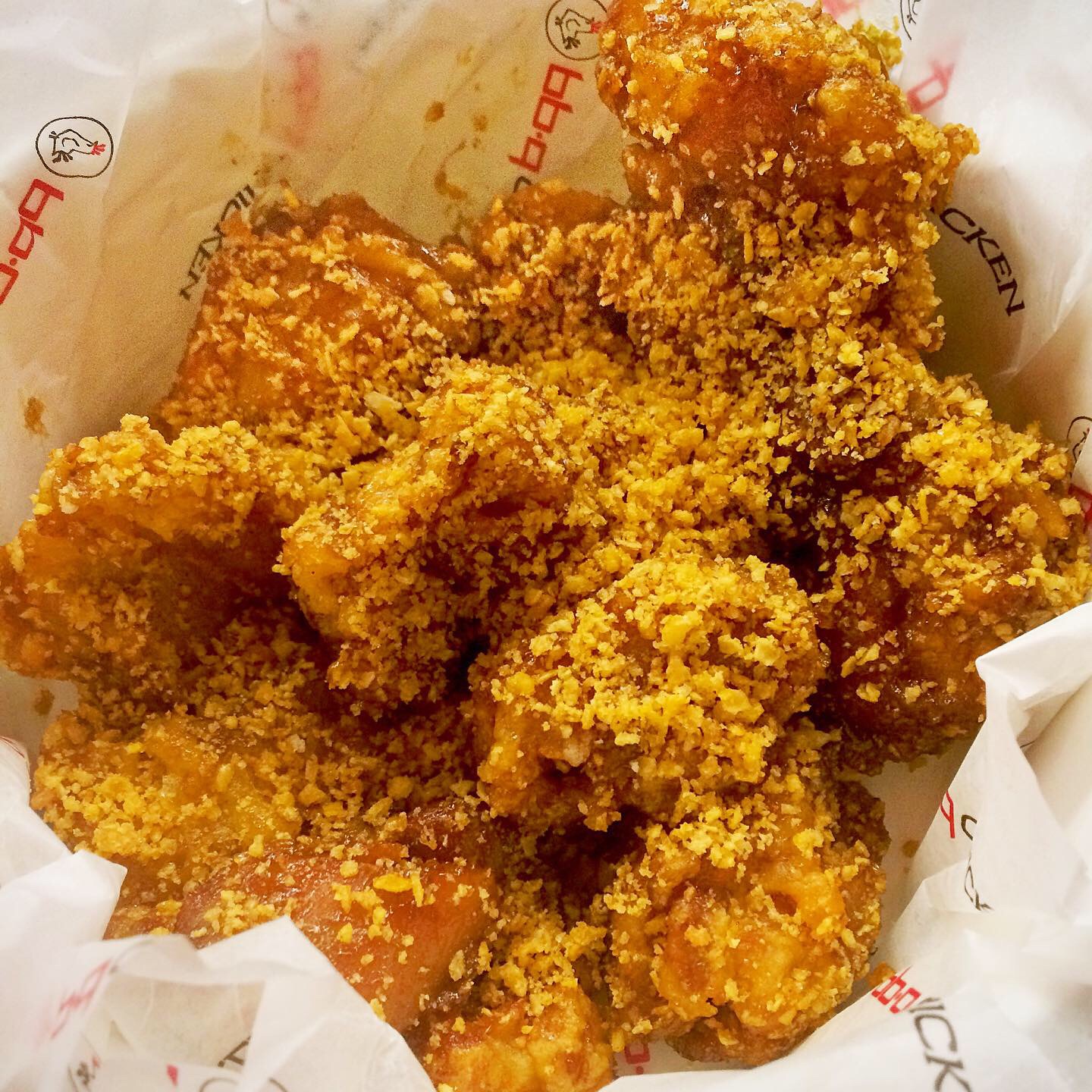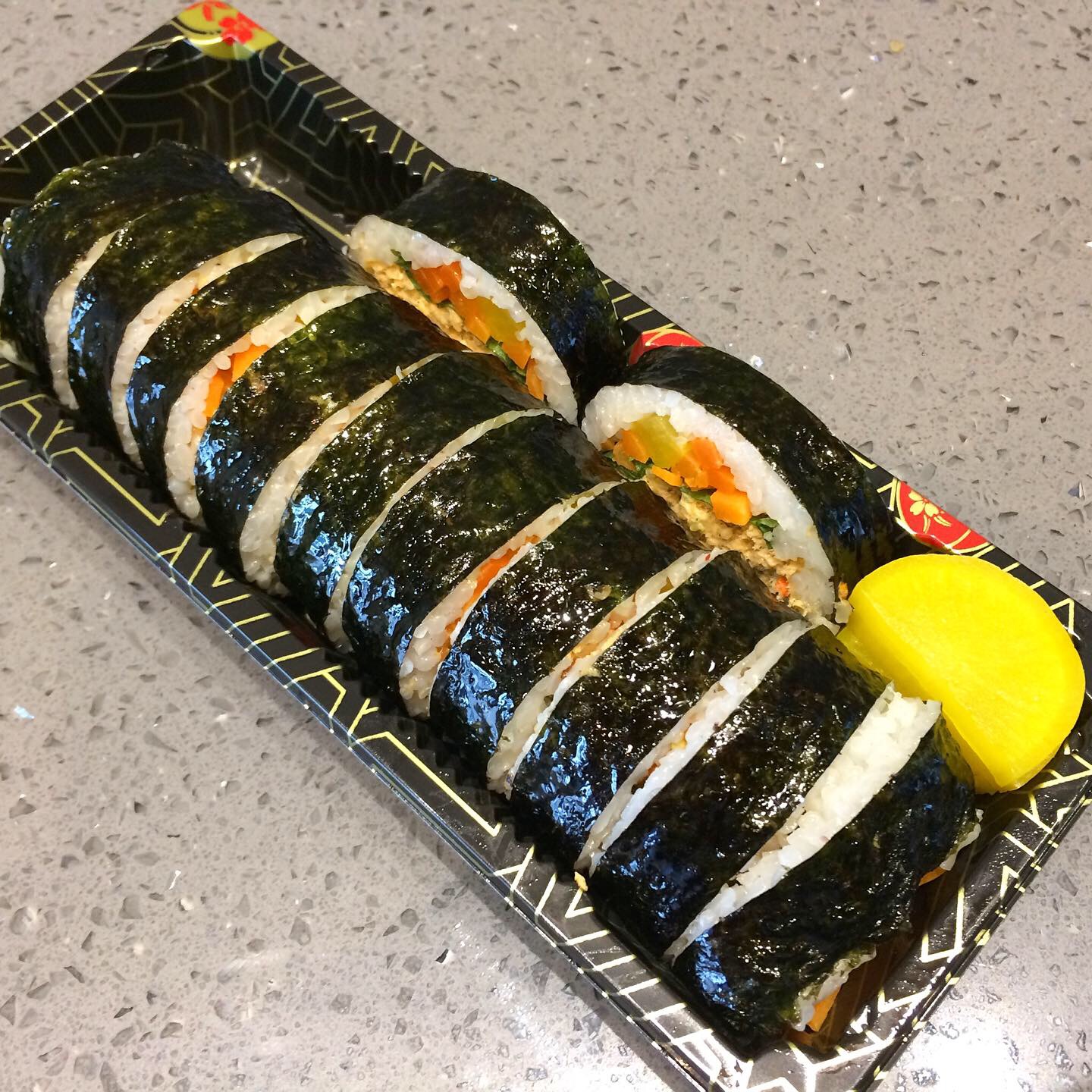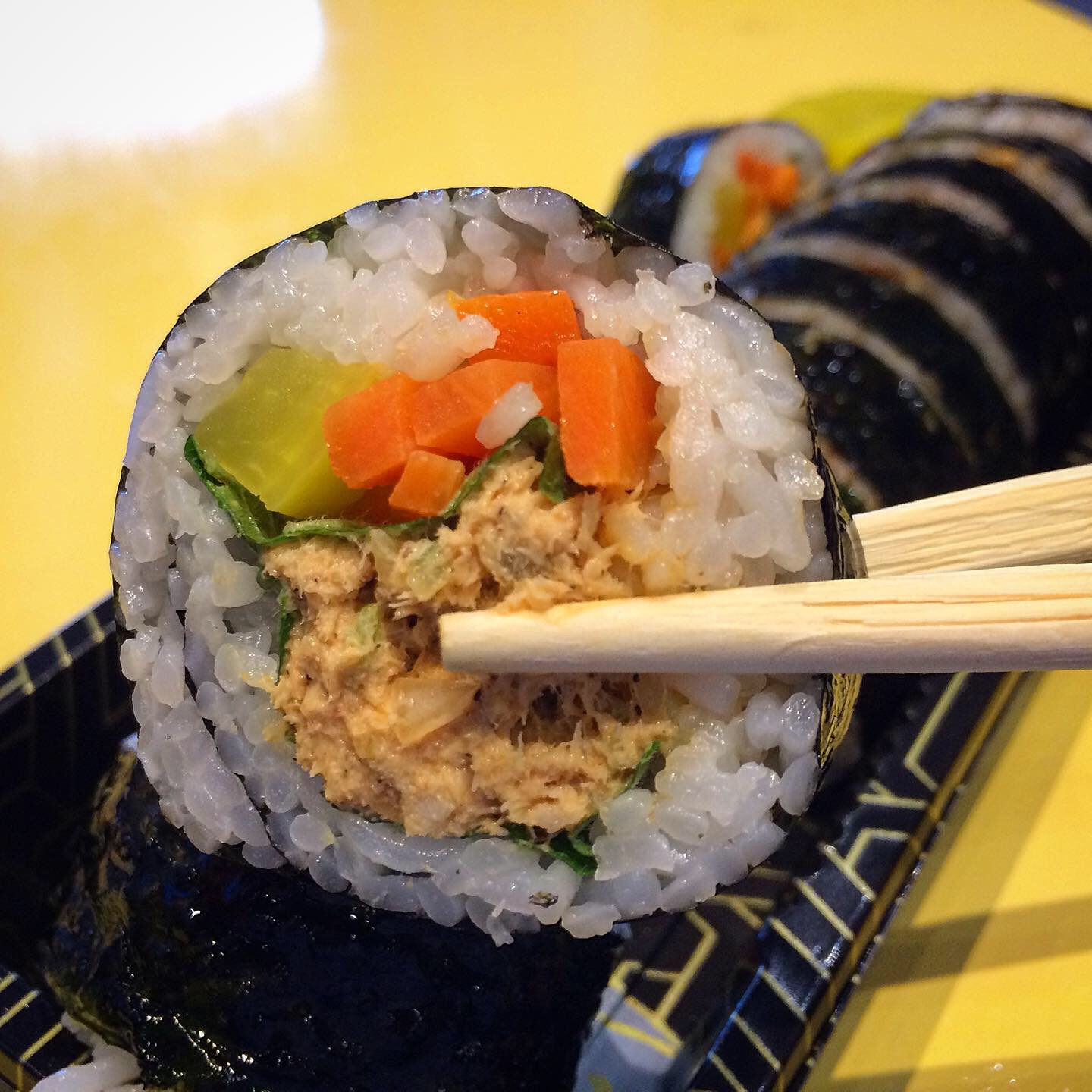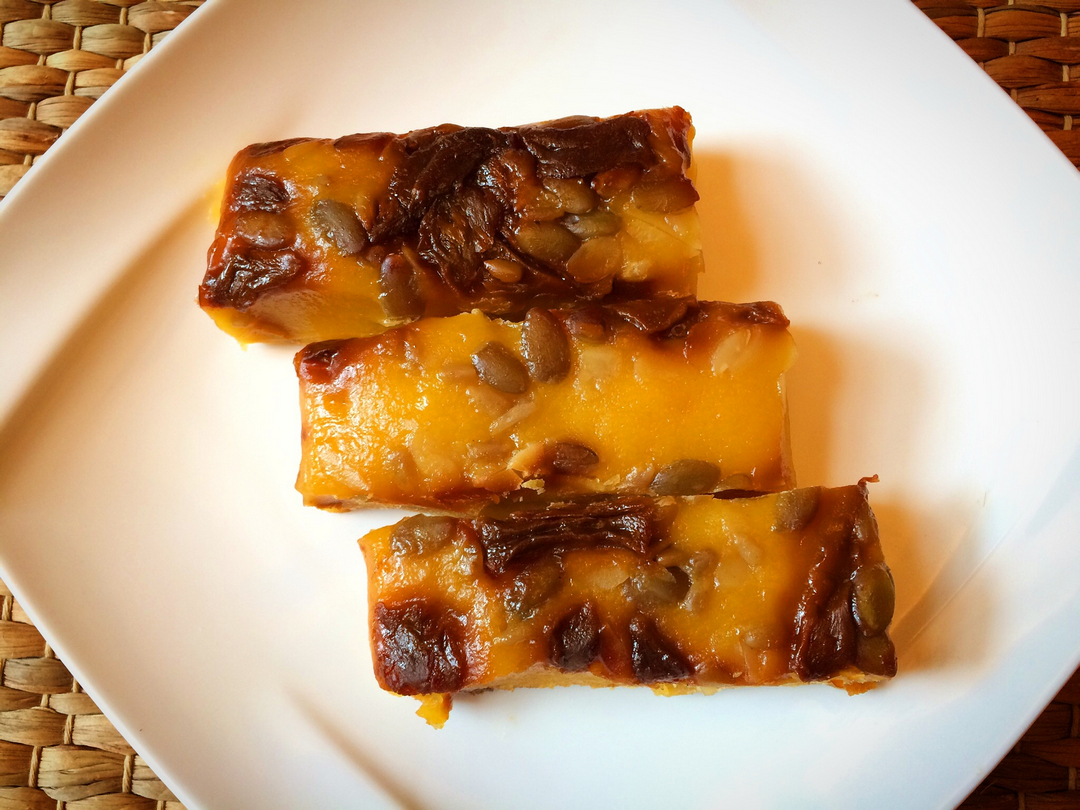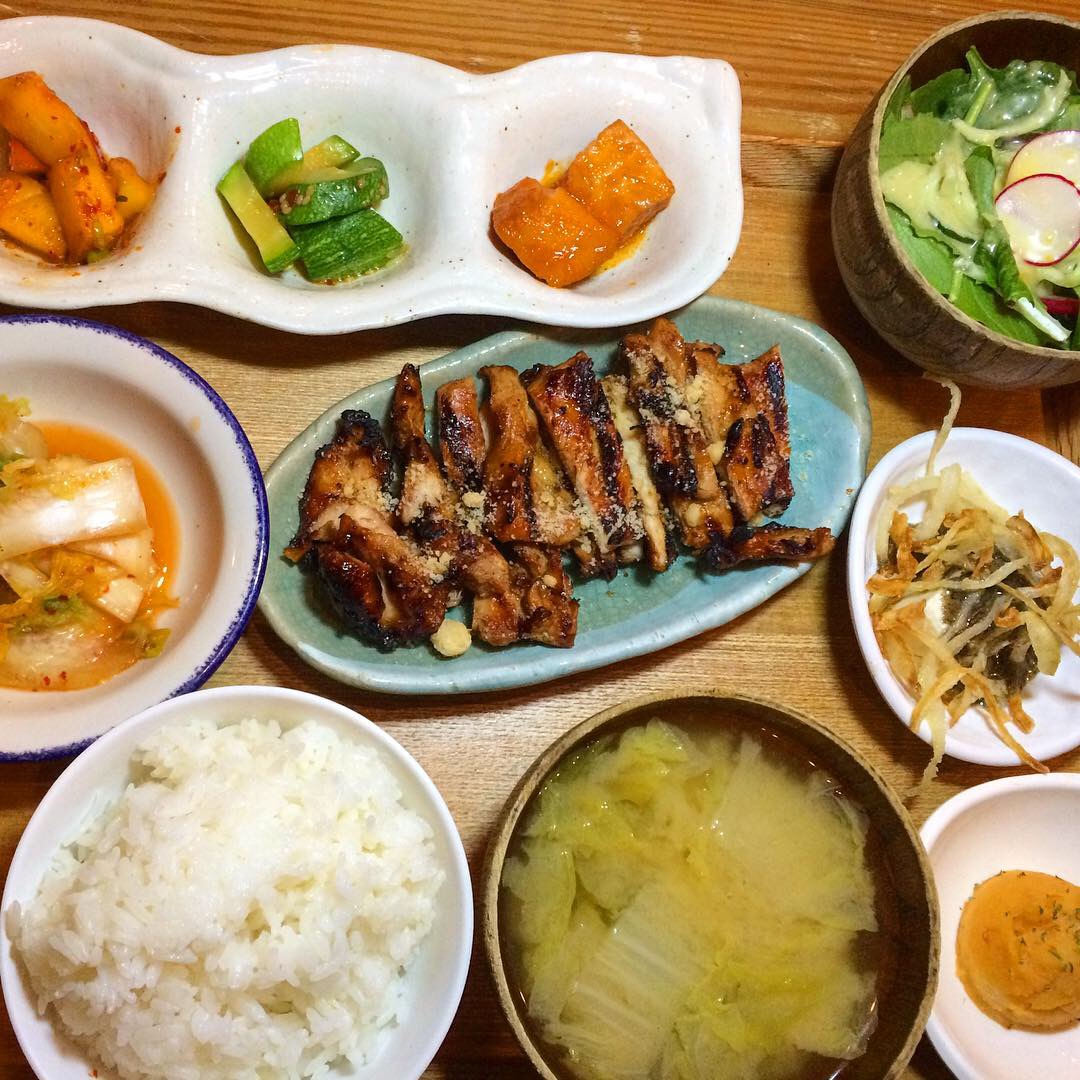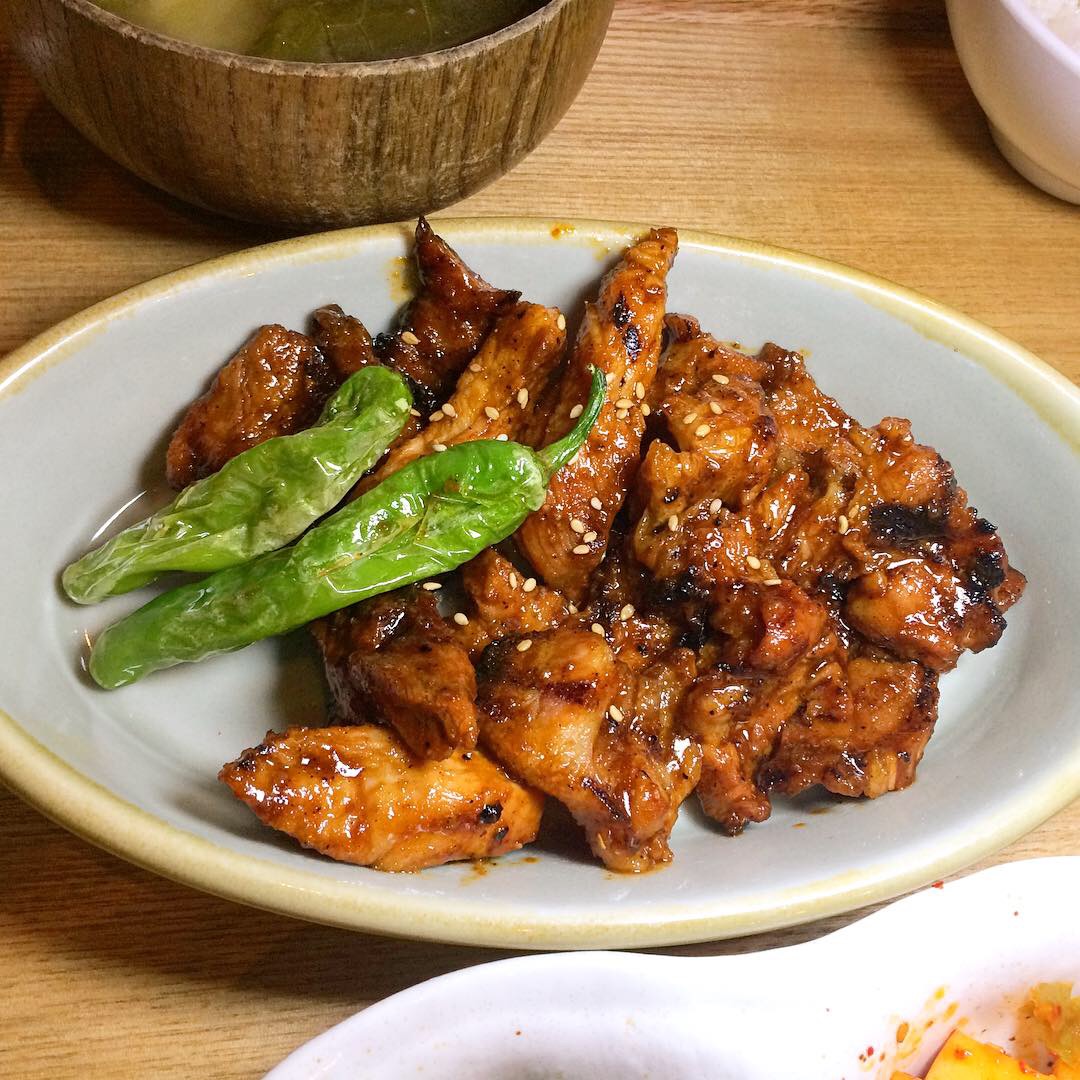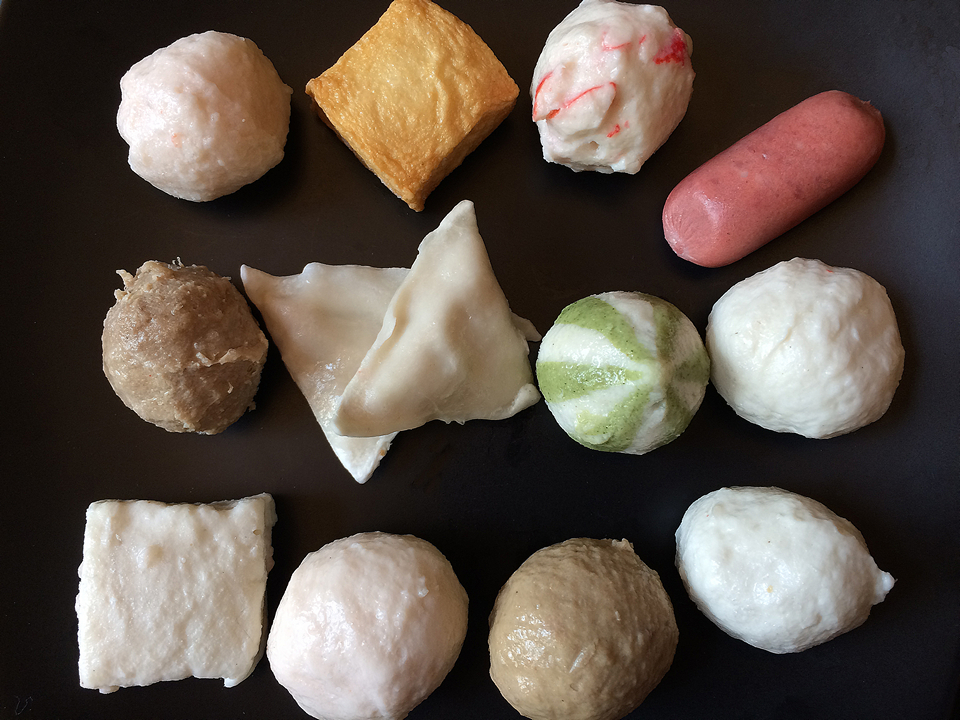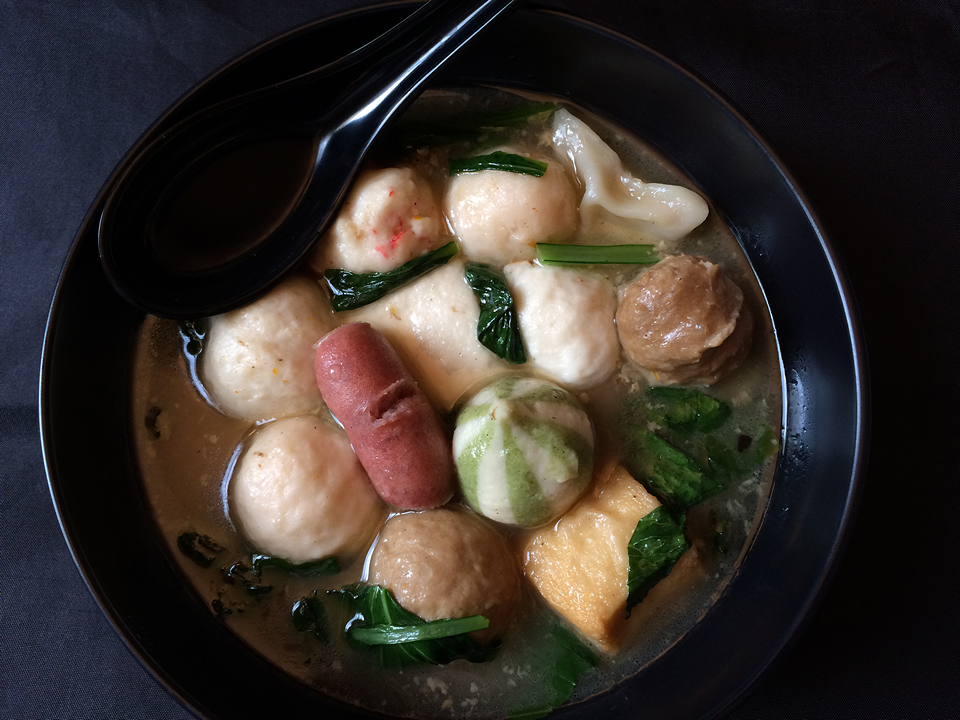(Note 1: I update this post annually because you can never have enough ethnic ice cream. Or at least I can’t! 😉)
(Note 2: Because of the COVID-19 pandemic, some businesses may be closed – temporarily, we hope. Please check before venturing out.)
Every August, as a routinely flushed, overheated child, I would join in chorus with my perspiring cohorts, boisterously importuning, “I scream, you scream, we all scream for ice cream!” Little did I realize that rather than conjuring dessert, I was conjugating it and probably laying the groundwork for a lifetime of fascination with foreign languages and world food.
We lived in close proximity to one of the best dairies in town; it was known for its wide assortment of locally produced natural flavors, certainly sufficient in number and variety to satisfy any palate. Perhaps my obsession with offbeat ice cream flavors is rooted in my frustration with my father’s return home from work, invariably bearing the same kind of ice cream as the last time, Neapolitan. Neapolitan, again. My pleas to try a different flavor – just once? please? – consistently fell on deaf ears. “Neapolitan is chocolate, strawberry and vanilla. That’s three flavors right there. If you don’t want it, don’t eat it.” Some kids’ idea of rebellion involved smoking behind the garage; mine was to tuck into a bowl of Rum Raisin.
Since the dog days of summer are upon us, that’s as good an excuse as any to consume mass quantities of ice cream. So that it doesn’t turn into a book, I’m going to circumscribe this post with the following definition of ice cream: if it doesn’t contain dairy (with one exception), it’s a different story – and one that I’ll tell eventually, so stay tuned for more about sorbets, Italian ices, granitas, paletas, piraguas, raspados, bingsu, kakigori, halo-halo, ais kacang, baobing, and myriad other contributions to the shave ice contingent.
And lest you think I’ve forgotten about all the hundreds of incredible flavors of ice cream and frozen yogurt that have gained popularity recently and that are liberally sprinkled all over New York City like so many jimmies on a sundae, I’ve drawn the line on the side of “international” as a descriptor within this piece – not that I have anything against fantastical frozen flights of fancy, just that I need to stop somewhere.
So with those two constraints in mind and with spoon in hand, let’s embark on a world tour of summertime scoops. We’ll consider two categories, common ice cream manifested in international flavors and indigenous ethnic ice cream styles.
Italy: One step removed from America’s favorite warm weather treat is gelato, Italy’s answer to ice cream. Using good old, down home American ice cream as our starting point for comparison, let’s examine the differences. American ice cream has more fat (more cream than milk plus the presence of egg yolks – with even higher quantities of egg yolks in French style ice cream) than gelato. It also has more air (“overrun”) than gelato which is why gelato seems denser. In addition, gelato is usually kept at a slightly higher temperature, another factor that contributes to its alluring consistency and concentrated flavor.
Gelato is available in many of the exciting and unexpected flavor bombs of the prevailing ice cream barrage, but because of its texture, it’s also uniquely suited to certain European flavors. Here are two of the scores of fine gelaterias that can be found around the city.
Il Laboratorio del Gelato, 188 Ludlow Street on Manhattan’s Lower East Side has over 200 flavors of gelato, many of which are true-fruit and fabulous, but I’m singling them out here because of a few that, in my opinion, work better as gelato than ice cream such as crème fraiche, olive oil, fior di latte, ricotta, and mascarpone.
By the same token, L’Albero dei Gelati, 341 5th Avenue, Park Slope, Brooklyn often has remarkable offerings like extra virgin olive oil, hibiscus, saffron, gianduja, torrone, ricotta, and burro e sale (butter and salt), another example of a flavor profile that works as gelato (yes, really), but I can’t imagine as American ice cream.
Thailand: Continuing in Park Slope, Sky Ice, 63 5th Avenue, boasts a Thai/Vietnamese roster that often includes Thai tea, roasted Thai coconut, durian, white miso almond, black sesame seaweed, and mangosteen, along with their savory non-dessert items (yet another story).
Thai Rolled Ice Cream, also referred to as “stir-fried ice cream”, has become a trendy craze of late. Found at venues like Minus10 Ice Cream and I-CE-NY and throughout Chinatown, the Village, and pretty much anywhere kids congregate, it’s made from an ice cream base that’s poured onto a metal sheet chilled to a temperature well below the freezing point. The mixture is manipulated on the sheet (mix-ins added optionally), smoothed into a thin layer where it flash freezes, and ultimately scraped up into a roll with a spatula that looks like a putty knife. It did get its start in Thailand, so I suppose it’s ethnic. It’s certainly cute.
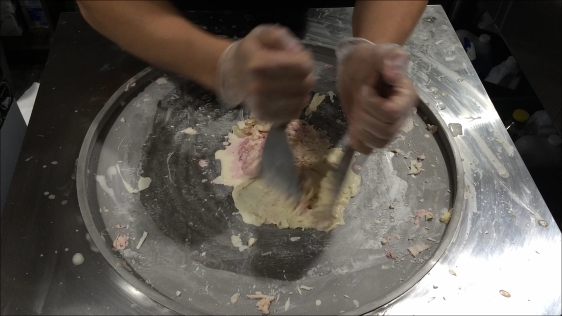

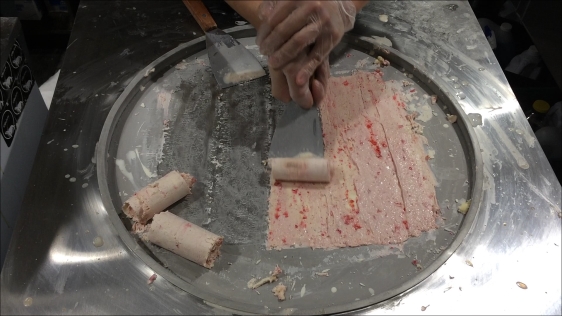
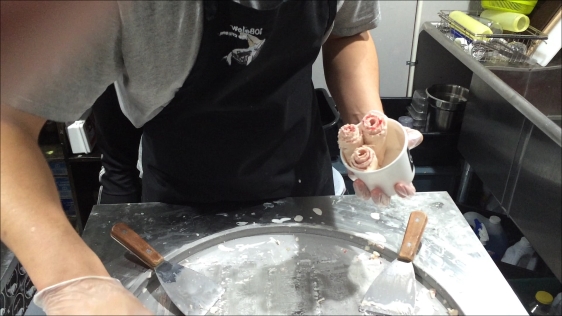 (Click on any image to view it in high resolution.)
(Click on any image to view it in high resolution.)
China: One of the sweeter perks of living in New York City is that instead of a passport, you only need a Metrocard to sample many of those aforementioned hundreds of incredible flavors and global varieties.
For over 30 years, The Chinatown Ice Cream Factory, 65 Bayard Street in Manhattan’s Chinatown, 115 Delancey Street in Essex Market on the Lower East Side, and 135-15 40th Road in Flushing, has reigned supreme as the king of homemade ice cream in delicious Asian inspired flavors. (Incidentally, they have well over a dozen non-Asian varieties, both innovative and familiar, all of which are excellent and listed on their menu – with a wink – as “exotics”.) Notable “regular” entries include…
• Dan Tat – You know the diminutive sweet egg custard tarts that you see all over Chinatown in dim sum parlors and bakeries? (You don’t? Then you need to join me on one of my Chinatown ethnojunkets!) Those are dan tat (sometimes, don tot) and originally of Portuguese provenance; here is a look at these goodies. This ice cream flavor owes its lusciousness to those pastries.
• Durian – A yellow fruit whose reputation is that it smells like hell but tastes like heaven. It might be an acquired taste but it’s well worth acquiring. (Read my post, Durian’s Best Kept Secret, for more information.)
• Pandan – The leaf of a tropical plant commonly used in Southeast Asian cooking, screwpine in English, green in color. It’s absolutely delicious, and in my opinion has the same kind of magical affinity for coconut that chocolate has for nuts or bacon for, well, anything.)
• Taro/Ube (Yes, they’re different, but we’ll get to the root of that in another post.) – I’m happy to report that these purplish starches are making serious inroads into becoming mainstream around these parts, and deservedly so.
…plus excellent versions of almond cookie, black sesame, lychee, and Thai tea. You’ve no doubt seen packaged pints of red bean, green tea, and ginger ice cream in your local market; Chinatown Ice Cream Factory’s versions are richer tasting if only because they’re freshly made, but beyond that, they’re a superior product.
Of course, there are additional ice cream parlors of Chinese character to be found in our city. Brooklyn is home to Sweet Dynasty Ice Cream, 5918 5th Avenue in Sunset Park, a tiny shop featuring handmade ice cream; their milk tea flavor is unique.
The Tropics: Since you’re already in Sunset Park, you really should check out Luvums Helado de Coco at 4716 7th Avenue. This is the “one exception” I declared earlier. Their coconut milk based helados are so rich and creamy, you might not even realize they’re non-dairy but with such delicious tropical flavors as soursop, guanabana, guineo, bizcocho, morir soñando, tamarindo, maíz, and lots more, I couldn’t bring myself to leave them out. They’ve opened a new location at 1124 Surf Avenue, also in Brooklyn.
Speaking of tropical flavors and Brooklyn, Taste the Tropics brand ice cream has a brick and mortar venue at 1839 Nostrand Avenue where you’ll find flavors true to their Caribbean roots like soursop, rum raisin, rummy nut, smooth and creamy stout, and great nut. Yes, stout and rum do figure significantly into Jamaican ice cream flavors; grown-ups can scream for ice cream too! By the way, great nut, as you might have surmised, is made with Grape-Nuts, the breakfast cereal.
And while you’re basking in Brooklyn’s trip to the tropics, pay a visit to the folks at Island Pops, 680 Nostrand Avenue, where flavors like soursop, sorrel, caramel orange bitters, and Guinness (of course) can be found. Look for them at pop-ups around the city as well.
Latin America: Needless to say, just about every Latin American country has its own spin on ice cream.
Manhattan has its share of purveyors of frosty goodness from sultry climes. One such is La Newyorkina at 240 Sullivan Street in the West Village representing Mexico with varieties like arroz con leche, canela cajeta, horchata, and chocolate chili. It’s made the old fashioned way, in a metal cylinder surrounded by ice and salt inside a wooden bucket. I had the opportunity to taste it at the World’s Fare in April; so nice, I went back twice.
Paleteria Los Michoacanos at 101-06 43rd Ave in Corona, Queens specializes in the most amazing, intensely flavorful paletas (Mexican ice pops on a stick) that I have ever encountered. Ever. They made the cut in this dairy-only post because of their outstanding milk-based flavors such as coco, galletas con crema, arroz, fresa de leche, pine nut, chocolate, queso con zarzamora (cheese and blackberry, first photo below), and chongos zamoranos (a Mexican dessert made from curdled milk and rennet).
Of course, I could do an entire story on international desserts in Queens alone where 138 different languages are spoken by people from over 150 countries. One of the joys of wandering through any ethnic neighborhood is stumbling upon delights like this Ecuadorian frozen confection sold under the name “Los Helados de Salcedo”. Read my post for more detail.
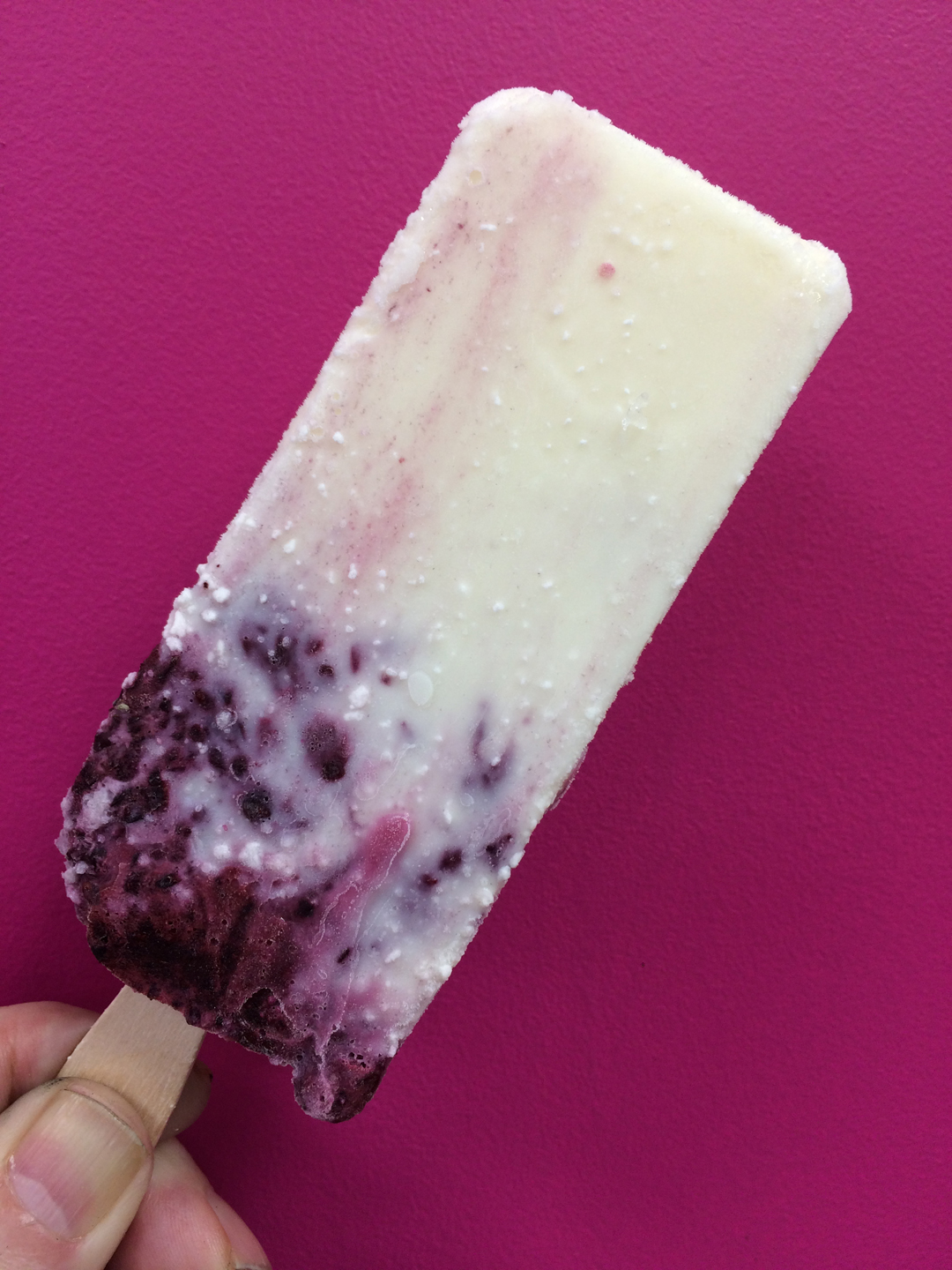
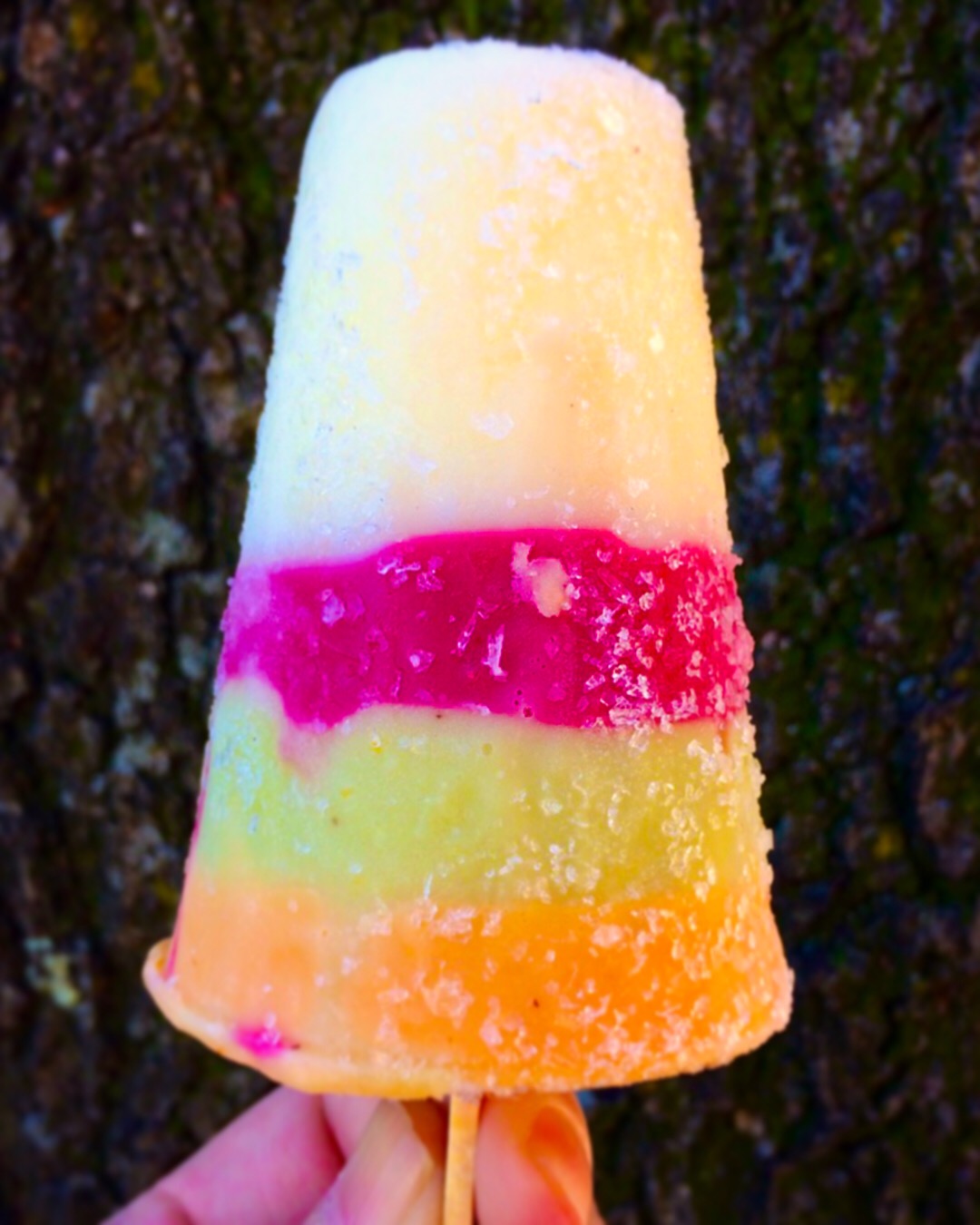

And that’s actually the best way to ferret out unusual taste treats. While wandering through a Peruvian enclave in Paterson, NJ, it was easy to find cherimoya, cupuaçu, and the extremely popular lúcuma (first photo below) as well as other flavors based on fruits cultivated in South America. I’ve never found fresh lúcuma in NYC but once, on an ethnojunket in Manhattan’s Chinatown, I came across the closely related eggfruit; their flavor has been compared to butterscotch or a mix of maple and sweet potato. I’ve also seen lúcuma ice cream at Creme & Sugar, 58-42A Catalpa Avenue in Ridgewood, proof that New York has pretty much everything if you know where to look.
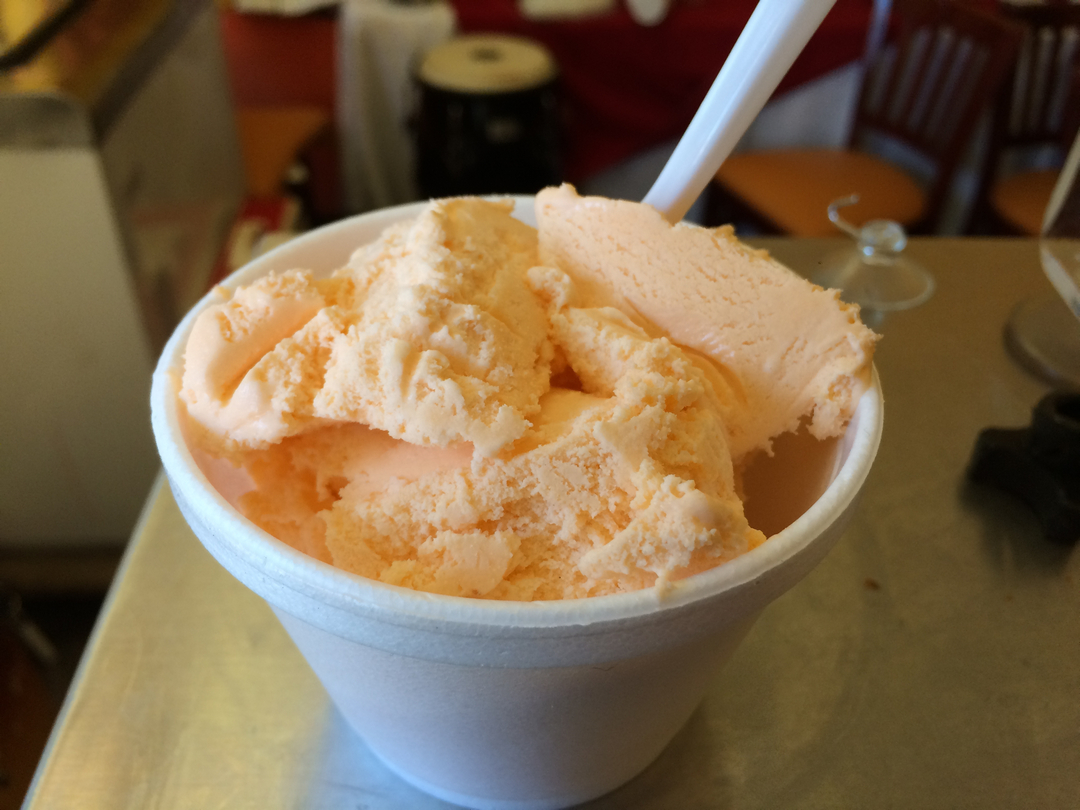
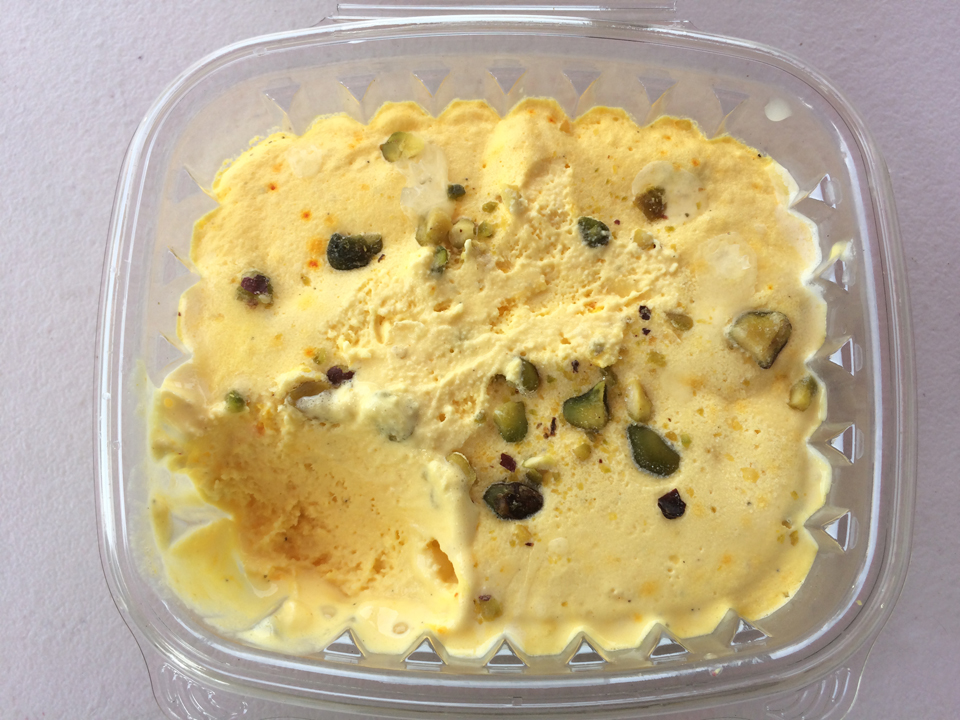
Paterson is also home to a thriving Middle Eastern community where we found this marvelous sunshine yellow homemade Persian Akbar Mashti Bastani (saffron rosewater ice cream) with pistachios. More about the Middle East in a moment.
The Philippines: Not to be outdone by any of these, emblematic Filipino flavors like ube (purple yam), macapuno (a gelatinous coconut variant), avocado, corn, jackfruit, halo-halo (mixed fruits and then some), quezo (yes, cheese) and combinations thereof are generally available at Filipino markets like Phil-Am Food Mart, 40-03 70th Street, Woodside, Queens and are not to be missed.
On the local front, Angela’s Ice Cream at 151 Allen Street in Manhattan has brought freshly made, small batch, Filipino ice cream flavors to New York City and each one is delicious. The story behind the story is that Angela had been making these at home for her husband who has a passion for the stuff – so much so that they decided she should share her talents with the rest of us, hence, her first business venture which opened on June 15, 2019. Dense and creamy, hand crafted with no artificial flavors (in others words, jackfruit is jackfruit, not a concentrate), it’s the first Filipino ice cream actually produced here in NYC. It’s currently available in mango, langka (jackfruit), ube, choc-nut, vanilla, avocado (and yes, it’s the real deal), pandan, and buko-macapuno.
Sweden: And speaking of local, only about a block from Angela’s you’ll find Bon Bon at 130 Allen Street. In addition to providing an overwhelming assortment of candy including Swedish salty licorice as well as the sweetish kind, they’ve recently added Swedish soft-serve ice cream, mjukglass. Its recipe is richer than conventional soft serve because of a greater measure of cream, but it’s the unique selection of sprinkles and syrups that provide the vital distinction. Shown here is vanilla (they have chocolate too) with licorice syrup and two kinds of toppings, salty licorice and salty licorice flakes. Amid seven syrups and eleven kinds of sprinkles, this is the combo that I enthusiastically recommend. They tell me that that this treatment is exactly what you’d find all over Sweden, right down to the brand of syrup and the unusual dispenser with its inverted bottles. (See second photo.) If you think you don’t like licorice, let alone salty licorice, this may well be your gateway drug.
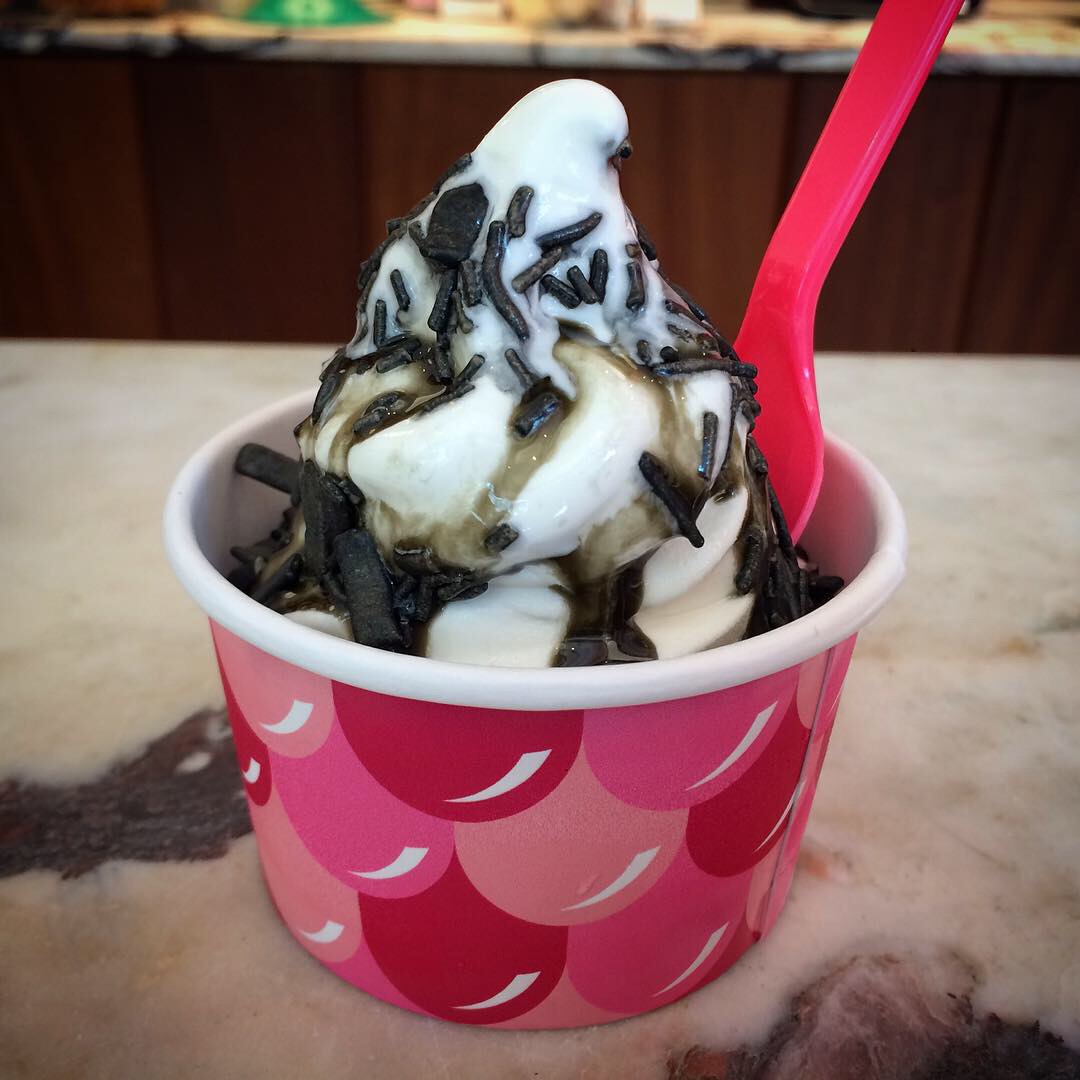
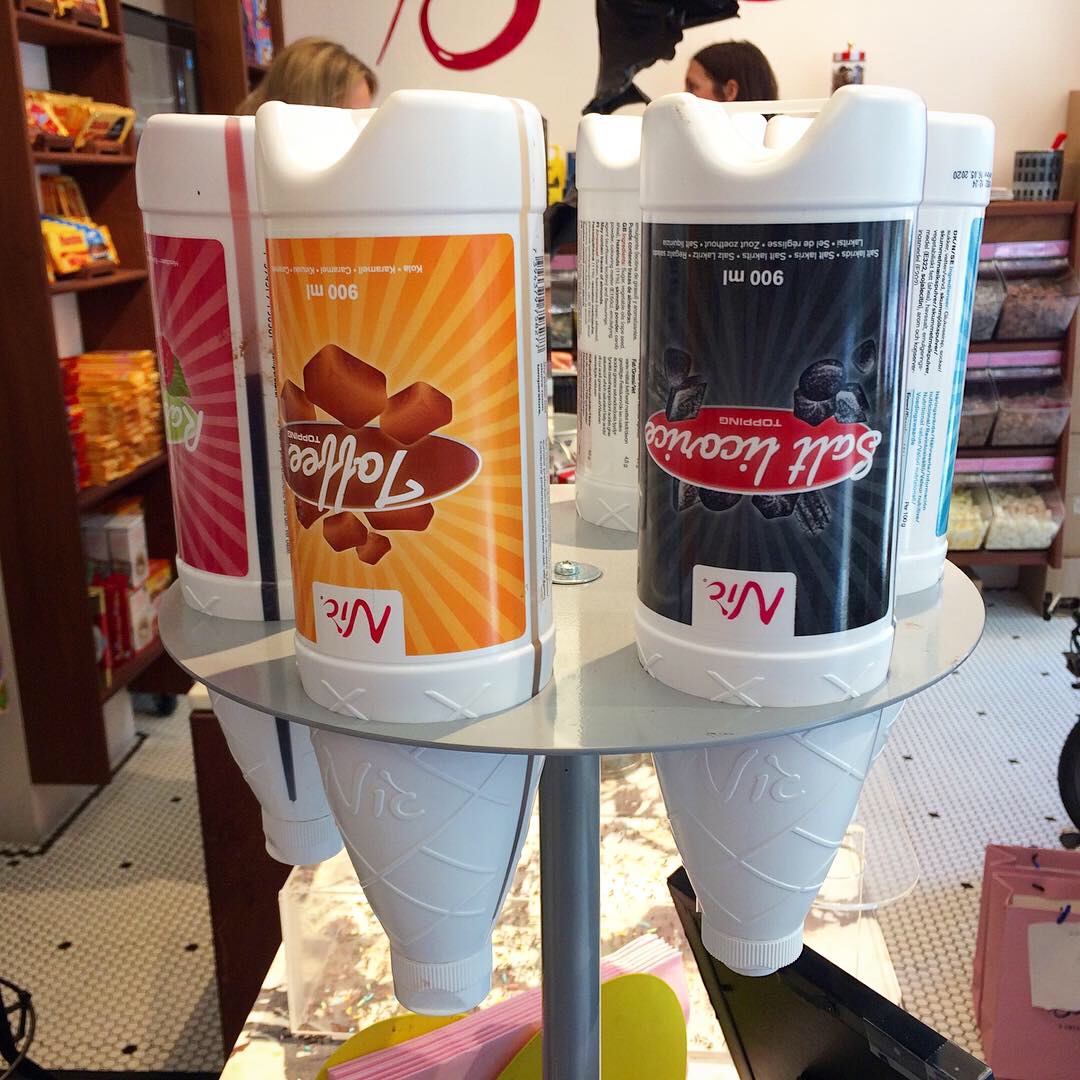
Every summer brings the Fancy Food Show, North America’s largest specialty food and beverage convention, to New York City’s Javits Center; with over 200,000 products on display from 55 countries and regions, I’m in my element. The event offers thousands of exhibitors the opportunity to introduce their wares to consumerland. A few participants from recent years’ spectacles:
Brazil: Among many products, the Brazilian pavilion highlighted Cremosinn, absolutely delicious frozen yogurt in an assortment of flavors including acai (of course), passion fruit, soursop, coconut, condensed milk, and azul. (Azul means blue, one of the favored “flavors” of the popsicles of my youth. How blue became a flavor has always eluded me; perhaps there were too many fruits like cherry, raspberry, and strawberry to be represented by a single immediately identifiable color so the food industry decided that a diacritical hue was called for, hence, blue. I still don’t know which fruit it corresponded to though. But I digress.) It comes in a cellophane packet that encloses a plastic pouch filled with the frozen yogurt; snip off a corner and suck out the sweet, creamy goodness.
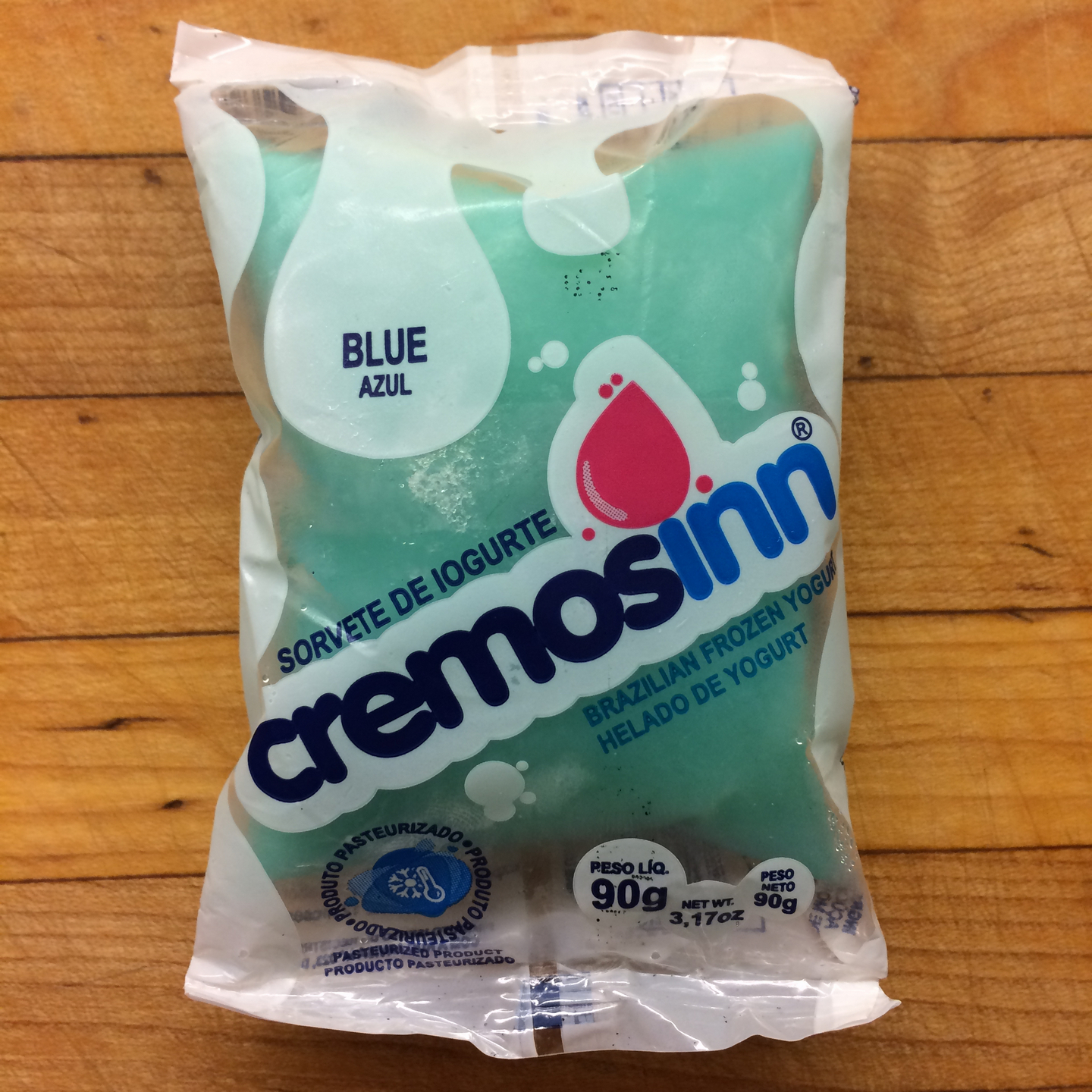
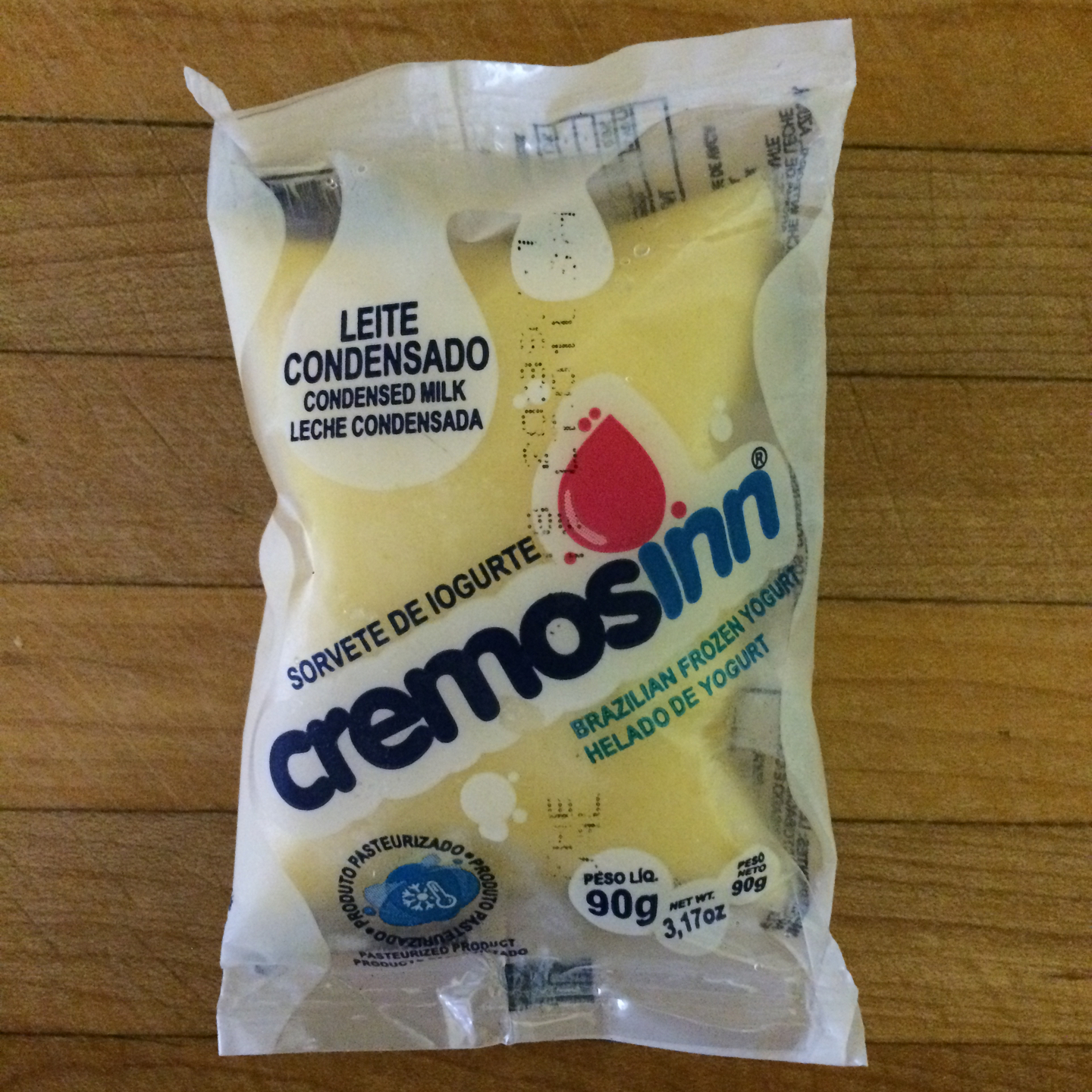
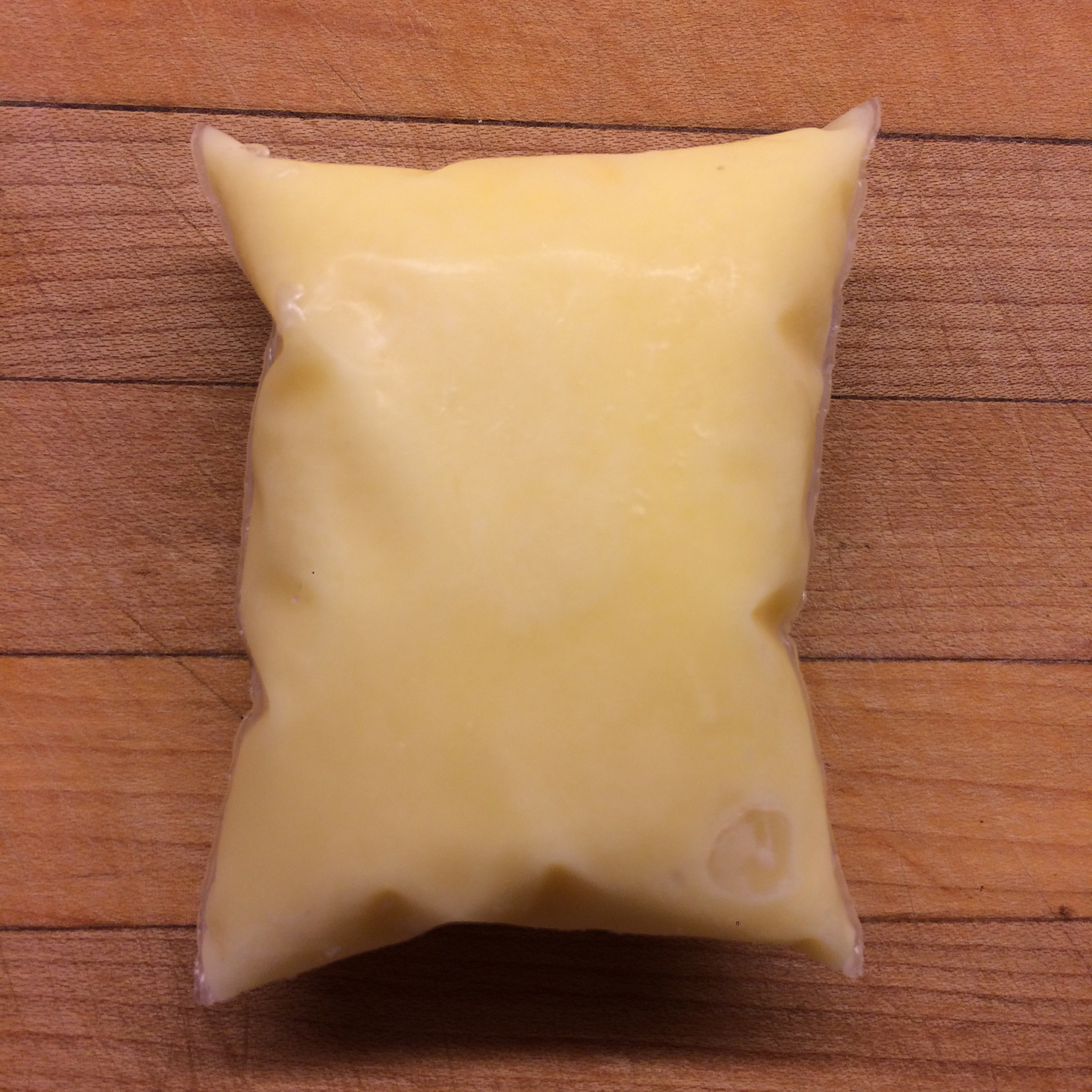
Japan: Mochi is a traditional Japanese food originally made from short grain glutinous rice that’s pounded and molded, often into chewy flattened orbs. Frequently a confectionary, its sphere of influence has extended far beyond the perimeter of its source. A new version was created about 35 years ago that wraps mochi dough around ice cream. This contemporary edition, technically called mochi ice cream, has become so popular that it’s often simply referred to as mochi.
Several companies displayed their renditions at the convention including Mr. Mochi, Sweety Ice Cream, My/Mo, and Bubbies, a Hawaiian contender. Flavors ranged from red bean, green tea, black sesame, and lychee to Kona coffee, chocolate peanut butter, and mango along with the more routine vanilla and strawberry among others. Note that in some cases, the ice cream core carries the flavor unassisted by the somewhat neutral mochi coating, but sometimes the doughy wrapper is infused as well and further enhances the experience. Look for these and other brands in Asian markets, particularly those that highlight Japanese goods. And while you’re there, take note of the seemingly infinite array of Japanese and Korean pops, bars, and ice cream novelties as well (melon is a popular flavor).
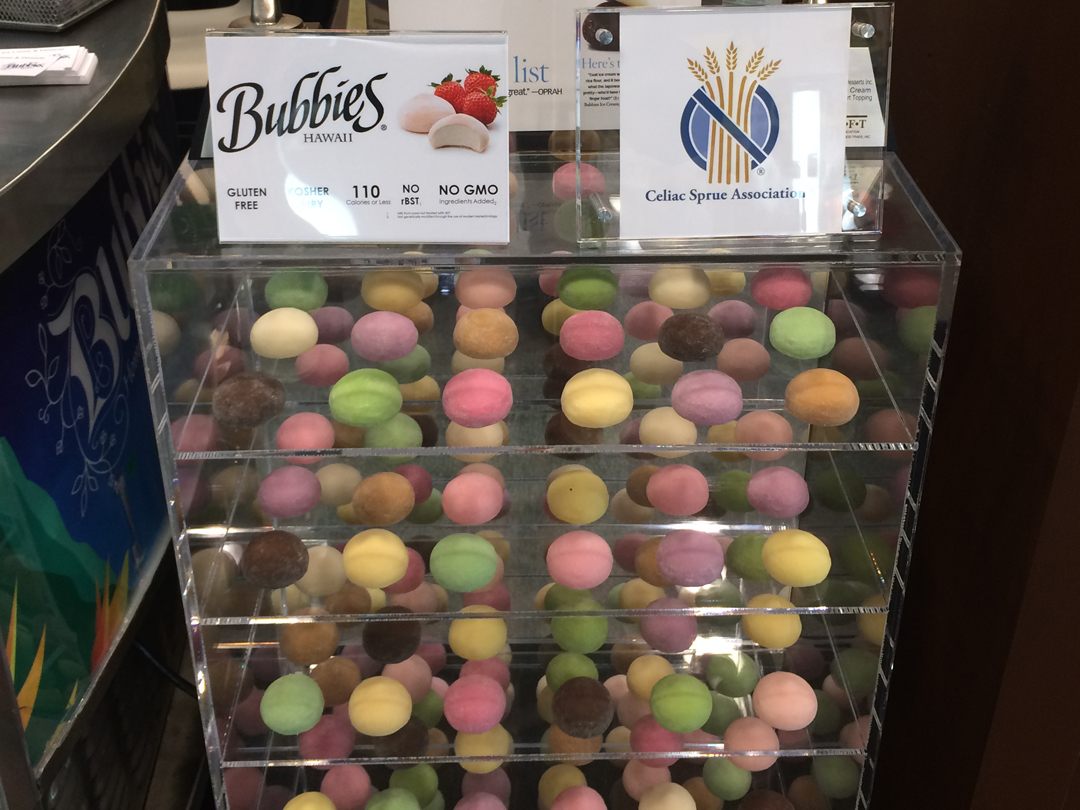
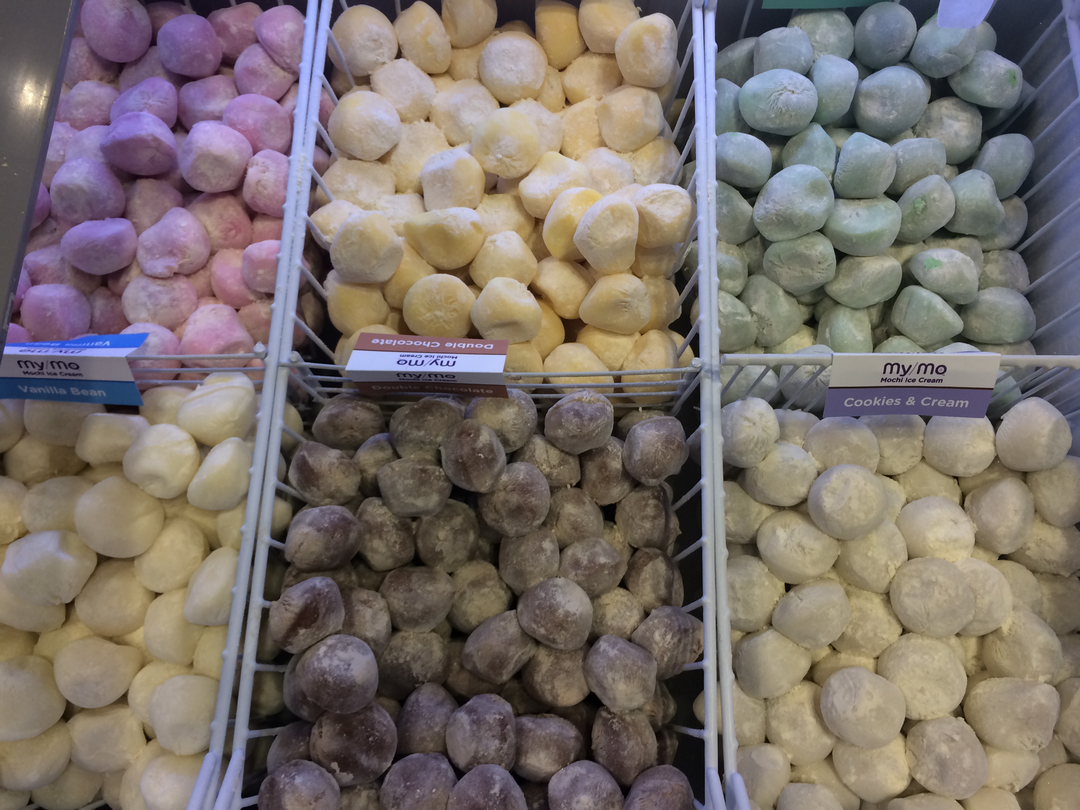
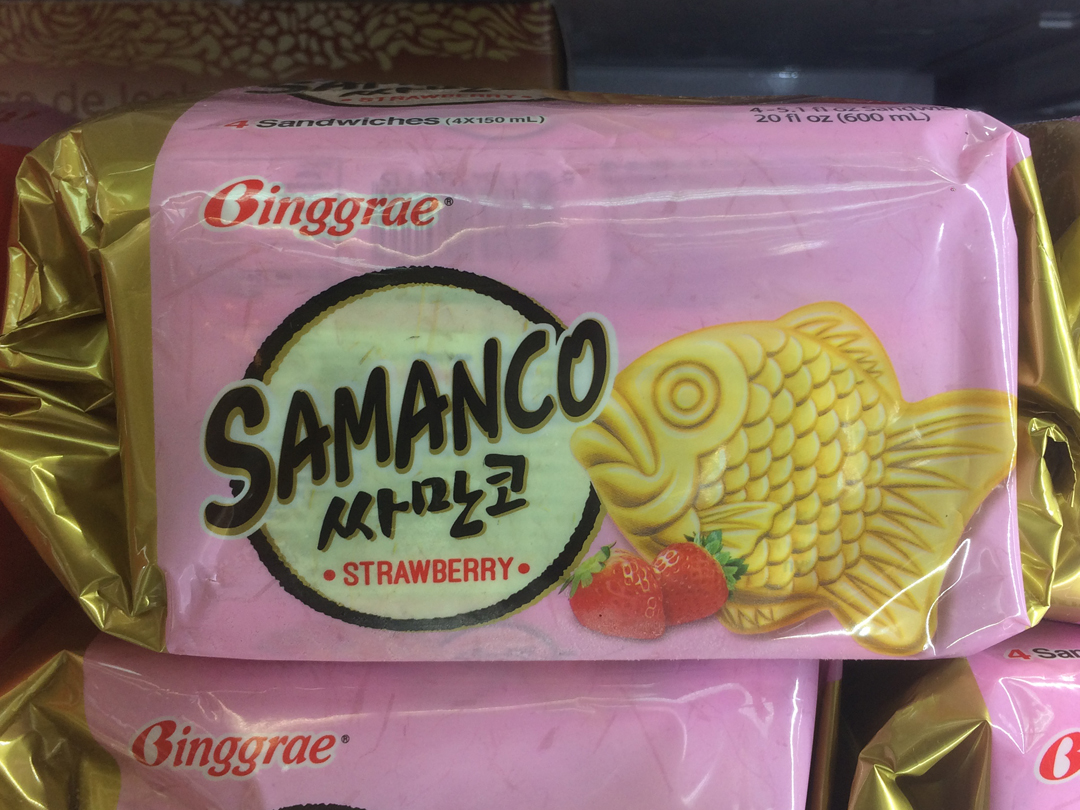
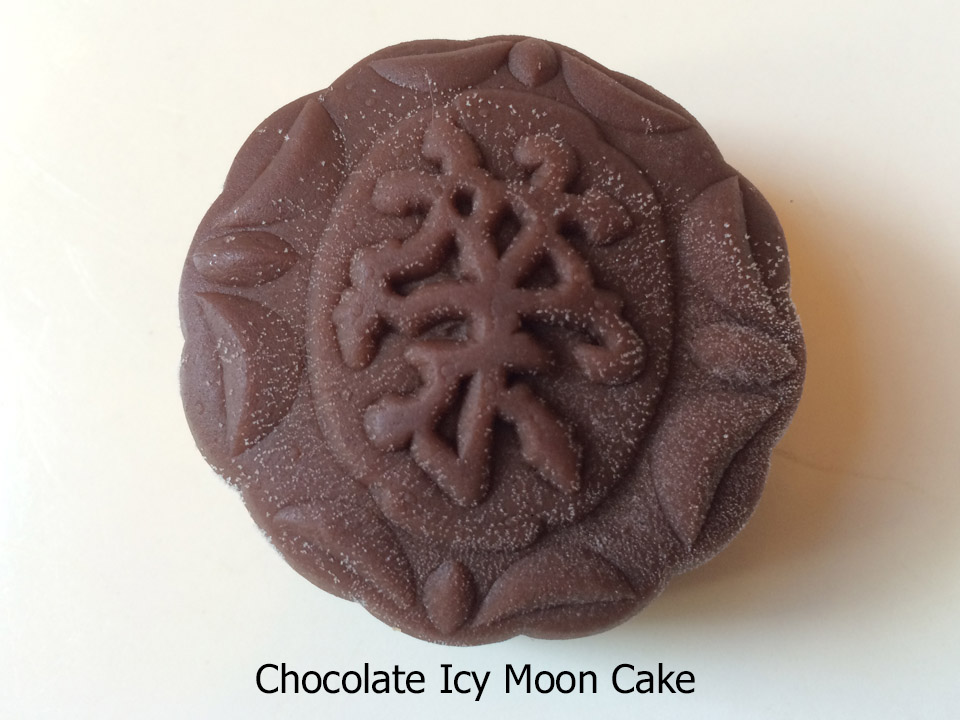
Even Chinese Mooncakes, not usually an ice cream commodity, are getting into the act with similar extravagances like Chocolate Icy Moon Cake. More about those in my Chinese Mooncakes Demystified post.
Korea: Back to world flavors of American style ice cream, Scoop by Spot was exhibiting at the Fancy Food Show with flavors like Misugaru, based on a Korean beverage; it’s available at Spot Dessert Bars in New York City. Noona’s (noona means “big sister” in Korean) showed off heritage flavors like toasted rice, golden sesame, black sesame, turmeric honeycomb and green tea.


Latvia was at the Fancy Food Show as well making a push to pop into the American marketplace with at least four brands of Latvian ice cream available in tubs, cones, pops, and bars with intriguing varieties like orange & macarons, raspberry-pomegranate, and black balsam & blackcurrant (first photo below). In addition to ice cream, the Latvian company Speka offered several varieties of curd snacks. Curd snacks are not unlike a cross between an Eskimo pie and chocolate covered cheesecake; individually wrapped, they come in an assortment of flavors from chocolate and vanilla to the more esoteric blueberry, blackberry, and raisin. They’re currently available as Russian/FSU products in markets throughout the city, with a high concentration in Brooklyn, of course. Always a high point on my ethnojunkets along Brighton Beach Avenue, I’ll do a feature about those soon.

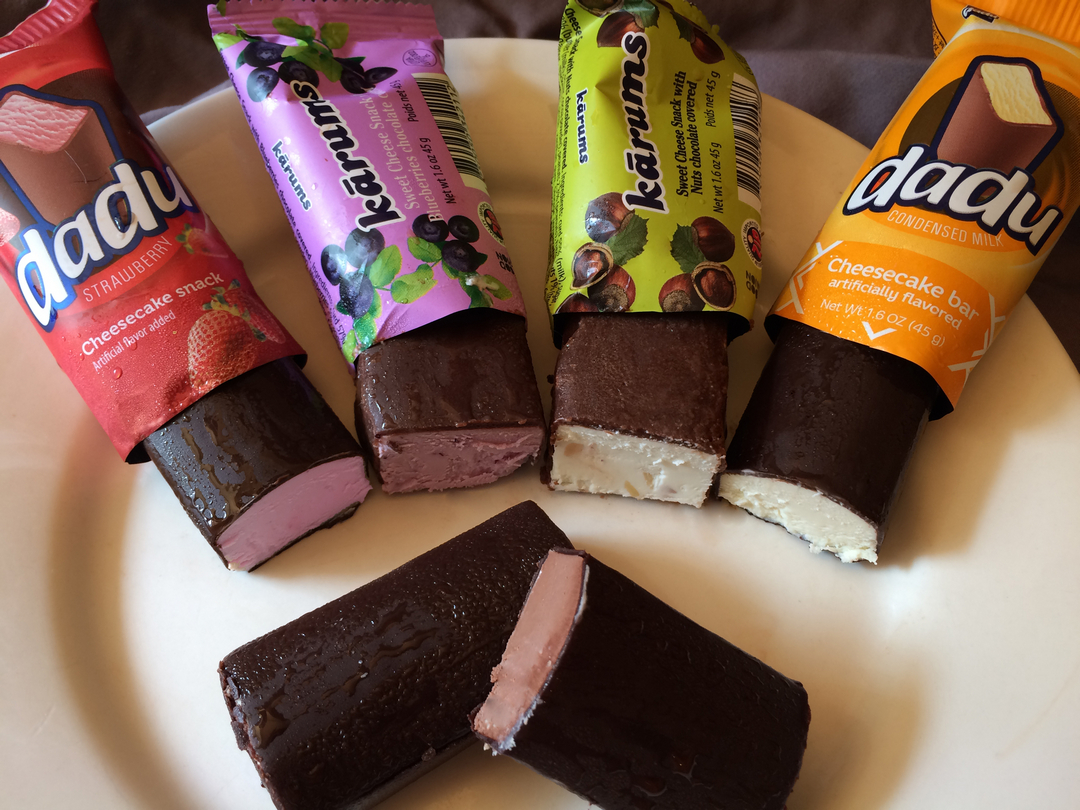
And speaking of Russia, ask anyone who lived there during the Soviet era about plombir and listen as they wax rhapsodic with nostalgia for this storied delicacy. Back then, the adage was that travelers came to Russia for only three reasons: to see the ballet, to visit the circus, and to eat ice cream. Plombir, named for Plombières-les-Bains in France, home to elaborate frozen confections, was manufactured to the strictest Soviet standards with a high butterfat content, no additives, and a creamy consistency.
I suspect that the plombir I find along Brighton Beach Avenue may be a frosty shadow of its former self, but since it’s too late to journey to the Soviet Union I can’t speak from personal experience. I can tell you that what’s here is good: every food store in the neighborhood carries a multitude of Russian brands, CCCP (Союз Советских Социалистических Республик), the Russian abbreviation for USSR, and Dadu are popular. Although distinctive, many of the Russian contenders are similar to American ice cream; most have more overrun and creaminess varies, some take the form of fancy ice cream cakes, but the flavors often run to the more prosaic chocolate, strawberry, and vanilla.
Unlike most American styles where cream leads the list of ingredients, Bandi plombir hands the top spot to milk; you’d anticipate a flavor profile that’s less rich, but the second ingredient is butter, so judge it on its own merits. In addition, individual hand-held treats like eskimo with its chocolate shell, tubular lakomka, and waffle cups of ice cream with a swirl of jam or sherbet in tempting flavors like black currant, caramel, and sweetened condensed milk are widespread as well.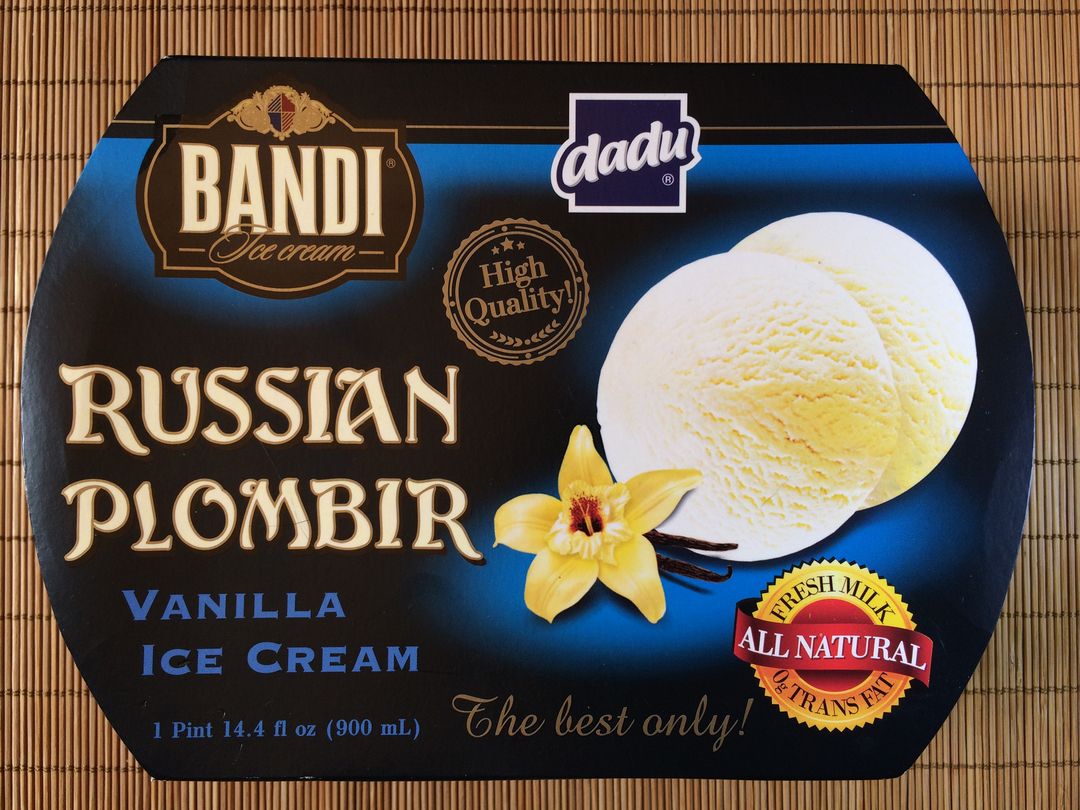

India: Malai Ice Cream always makes an appearance at the trade shows. Malai means “cream” and also refers to a particular flavor of kulfi, the Indian ice cream (more about that in a moment), but in this case it’s the name of Pooja Bavishi’s company which launched in 2015. Shot through with Indian spices and churned out in artisanal, small batches in Brooklyn, the quality is readily apparent. Their gelato-like product comes in flavors like masala chai, rose with cinnamon roasted almonds, Turkish coffee, orange fennel, golden turmeric, star anise, lemon cardamom, sweet corn saffron, toasted nutmeg, baklava, carrot halwa, and more – basically, something for everyone. Visit their new (2019) shop at 268 Smith Street in Cobble Hill, Brooklyn, but if you can’t make it, look for their product line in Whole Foods among many other markets.
Newcomer Kaurina’s was exhibiting their product at the show as well; they emphasize their use of all natural ingredients with an eye towards capturing the health conscious market. Even their chocolate, a flavor kulfi makers often don’t quite have a handle on, was great.

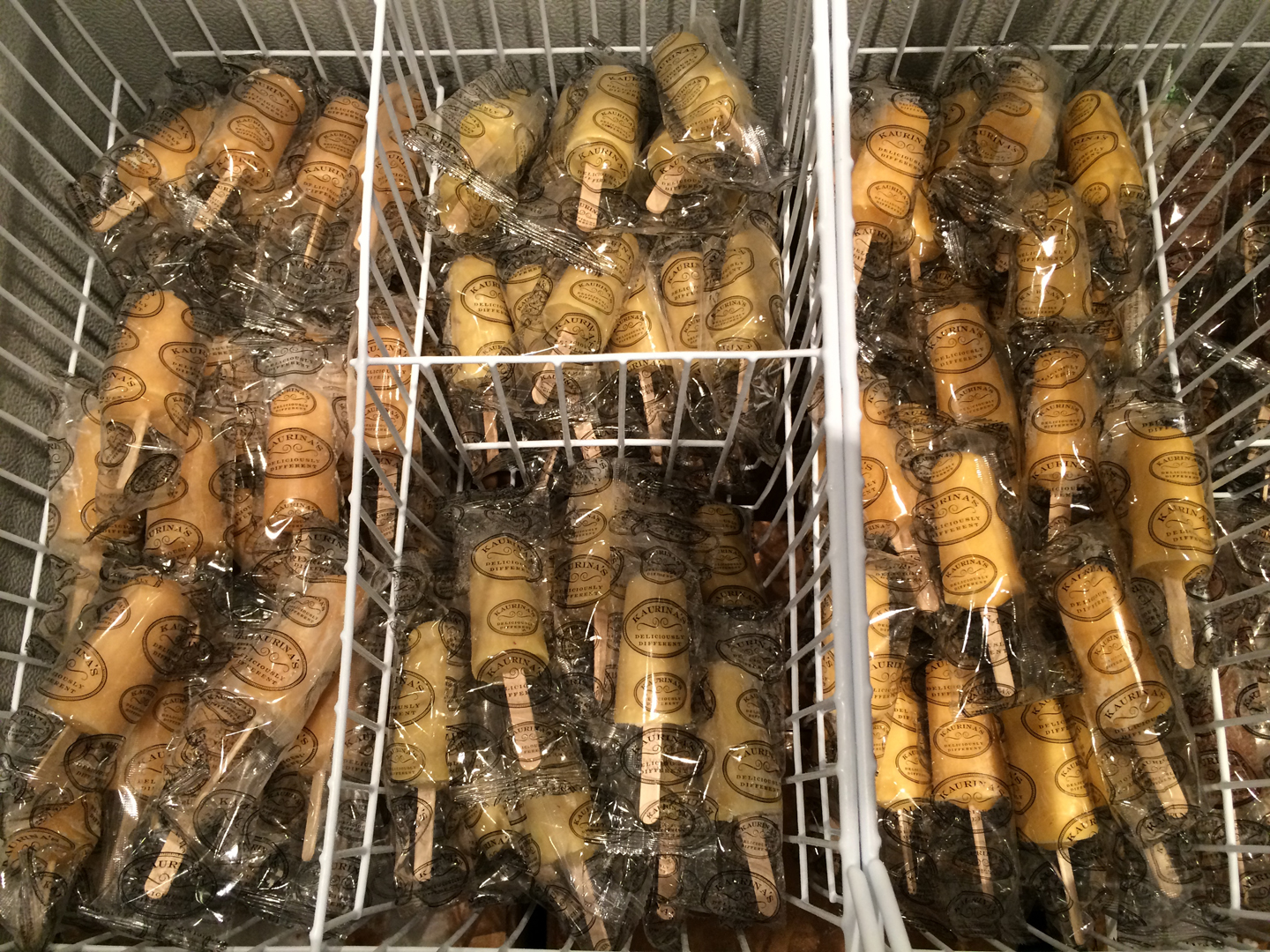
Leaving the trade shows behind and returning to the real world, Kwality Ice Cream, 1734 Oak Tree Road in Edison, New Jersey and 258-030 Hillside Ave, Floral Park, is part of a chain of ice cream shops that feature dedicated Indian flavors including sitafal (custard apple), chickoo (sapodilla), jamun/jambul (black plum), kesar (saffron), pista (pistachio), and dozens more, all of which are authentic and delicious. You’ll find similar shops in similar Indian neighborhoods in New Jersey like Iselin and Jersey City.
Back on the streets of New York City’s Little Indias (Lexington Avenue around East 28th Street in Manhattan and 73rd-74th Streets just off Roosevelt Avenue in Jackson Heights, Queens), you’ll find the aforementioned kulfi, available often (and best) as pops but also in tubs in Indian markets.
I must confess that kulfi may be my favorite ethnic ice cream; sweet, creamy, intensely flavored, slightly chewy – so good it’ll make your brains fall out (as Soupy Sales used to say). It starts with milk that’s been cooked down for an eon or two, flavors are added, and it’s poured into molds and frozen directly, not churned. This process contributes to kulfi’s dense texture because no air has been blended in.
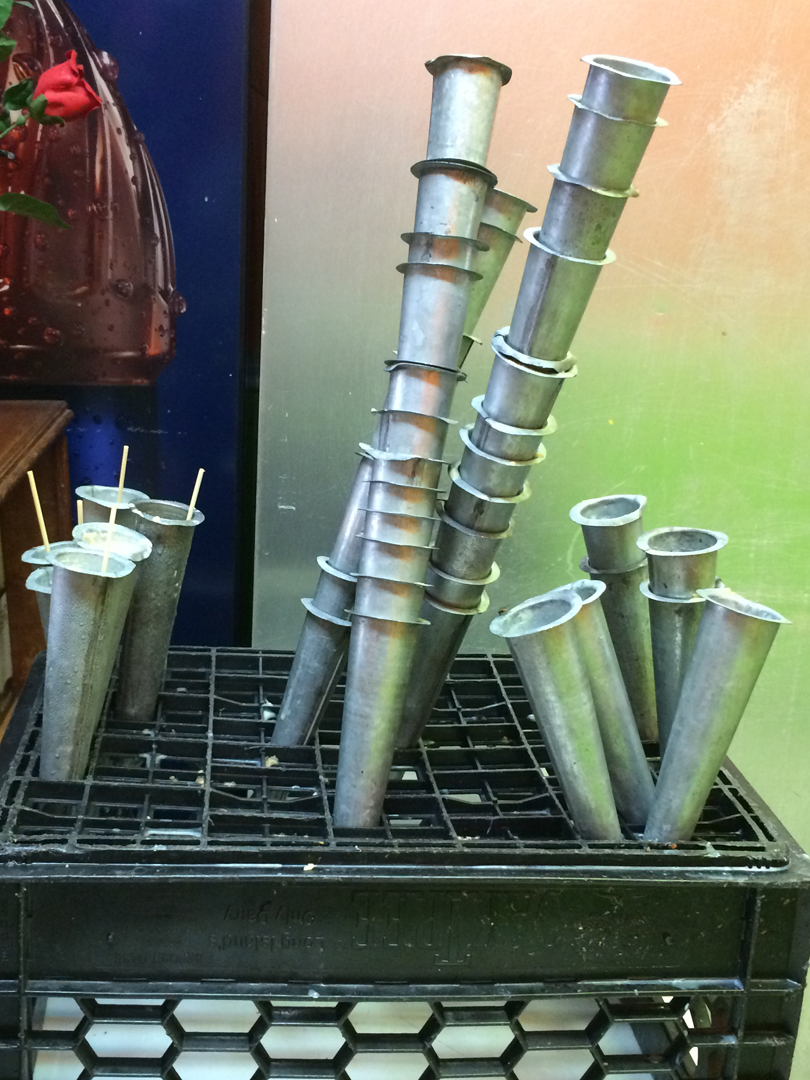
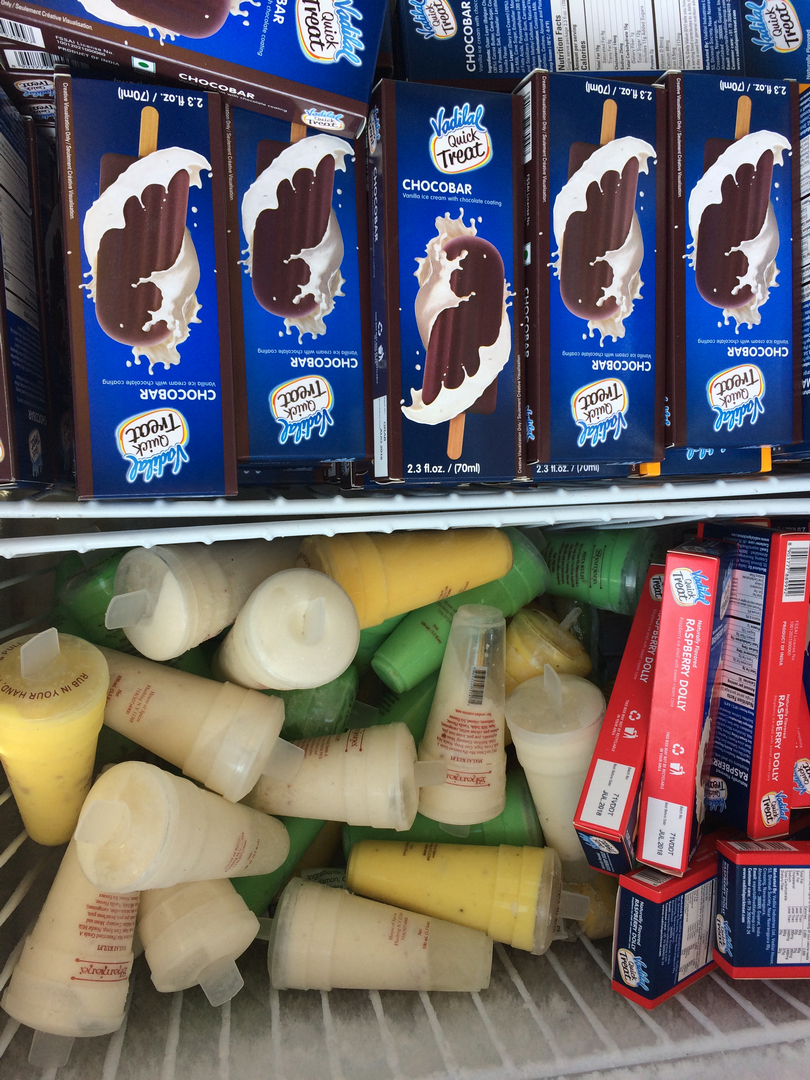
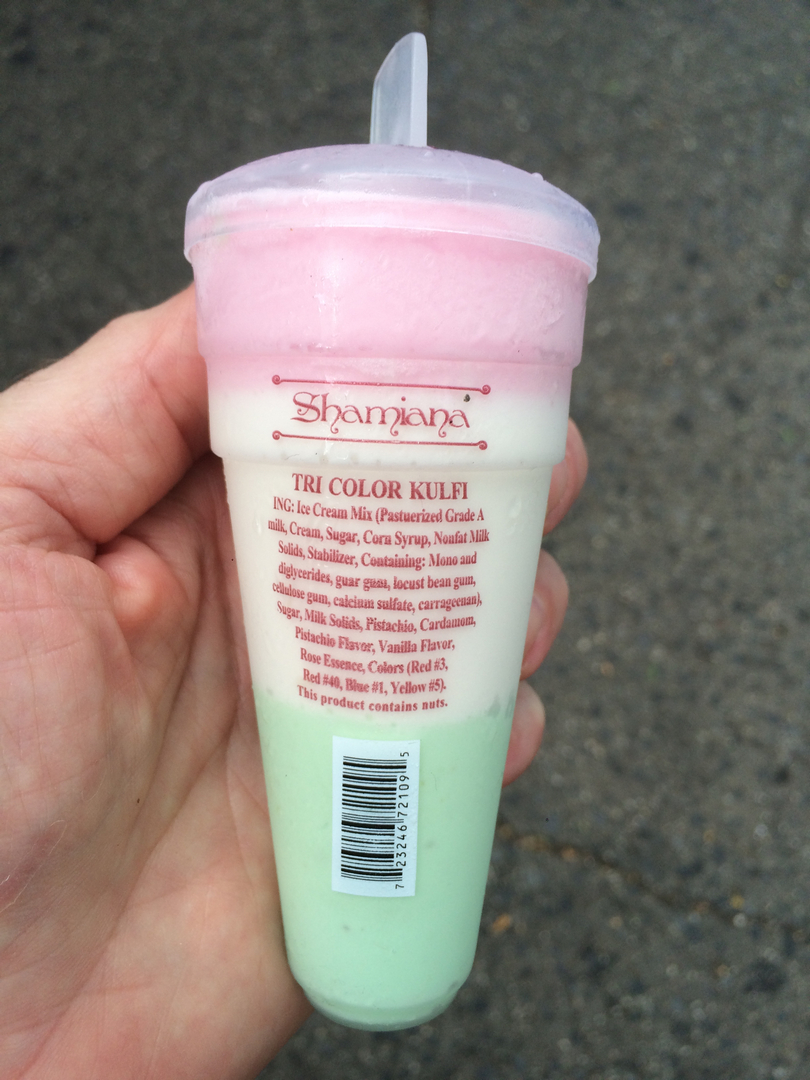

One of the classic flavors is malai, but it’s not merely cream; malai kulfi is aromatic with cardamom and nuts, sometimes saffron, sometimes rosewater. But malai is only the starting point along the road of ubiquitous kulfi flavors like pista (pistachio), mango, and almond with other more exotic examples to be found as well.
Slow to melt because of the lack of air, plastic encased kulfi pops are sometimes rolled vigorously between warm hands to get the process started. Favorite brands include Rajbhog and Shahi Kulfi for its unique almond variety. The kulfi that’s found in prepackaged pint and quart containers is available in a wider array of flavors, but in my opinion isn’t nearly as good as the pops.
Look to Patel Brothers on 37-27 74th Street in Jackson Heights, Queens, for both styles, as well as in refrigerator cases inside and outside mithai shops like Maharaja Sweets at 73-10 37th Avenue and Rajbhog Sweets at 72-27 37th Avenue.
The Middle East: While I’m sure there are some who might not immediately discern the difference between standard issue American ice cream and gelato (and diverse recipes make it more problematic), there’s no misidentifying the unique personality of Middle Eastern ice cream. It’s characterized by a pleasant sticky chewiness and make no mistake, mastic’s magic is the key.
A few summers ago, I stumbled on Holon, an Israeli/Middle Eastern market in Midwood, Brooklyn where I found Amazing Arabic Ice Cream, an absolutely delicious, hand-crafted, orange blossom mastika, “a Syrian delicacy that takes you back in time”.
Saffron & Rose from Los Angeles packages their Persian Golo Bol Bol for sale nationally at Middle Eastern markets; the saffron version is pretty good. They also make an icy version of falooda – you’ll recognize it by its congealed vermicelli and pinkish hue – but it’s not dairy-based so we’ll eschew it here.
You might run across Lezzetli ice cream in your travels; their most authentic flavor is mastiha (so many spellings!) which is resiny, woodsy and probably not for everybody. Aside from that flavor, the product seems to be sort of a cross between American and Mediterranean styles, but I’d suggest you go for the real deal: booza and dondurma.
Booza, an ice cream that hails from the Levant and Egypt, is known for two qualities, its stretchy consistency and its ability to resist melting. The elasticity comes from mastic, the resin that makes Turkish Delight delightfully chewy, and its prowess in fending off the consequences of Middle Eastern heat stems from sahlab (aka salep), a thickener made from ground orchid tubers that’s also used in beverages and puddings.
Turkish dondurma and Greece’s kaimaki are similar to booza, but in my experience, locally at least, booza boasts more bounce. At the Fancy Food Show, Pasha Delights touted their dondurma which they subtitle “Turkish Style Gelato”. Note too that YMMV (Your Mastic May Vary): recipes differ from one purveyor/manufacturer to the next, so expect varying degrees of mastickiness.
A stroll along 5th Avenue in Brooklyn’s Bay Ridge (which probably should have earned the moniker Little Levant, but didn’t) turns up a handful of opulent sweet shops, some of which feature mastic ice cream. (Did you know that Beirut and Bay Ridge are cognates? Just kidding.)
Cedars Pastry at 7204 5th Avenue usually carries the basic ashta (you might see it as kashta or qashta) mastic flavor, and always has the pistachio version; you can buy it there by the cup. Hookanuts, a few storefronts away at 7214, has pistachio, almond, and other favors as well, available in their freezer case. Antepli at 7216 is Turkish based and sells dondurma scooped fresh from tubs and packaged in cups and squeeze-up pouches.
If you’re a hard core booza booster, you should definitely make the trip to Republic of Booza at 76 North 4th Street in Williamsburg, Brooklyn. They up the ante on mastic/sahlab ice cream with the densest, stickiest booza I’ve found (see photos below). Read my post about Republic of Booza here.


Honorable Mention: A unique ice cream parlor if ever there was one is over-the-top Max and Mina’s Ice Cream at 71-26 Main Street in Flushing, Queens. Not listed above since they aren’t really about international ice cream, they have created scores of unusual flavors over the years including nova lox, herring, horseradish, and cholent among others which could certainly be considered ethnic. Note that each time I’ve ventured in, their flavor list was different, presumably to accommodate the latest experiments. Their babka ice cream really takes the cake!
For the sake of completeness and with the highest of hopes for its return if only for its novelty value, I’ll mention Uyghur Ice Cream from Xinjiang province in China. For one brief, shining moment, the sweet, milky, brown sugar flavor ice cream could be found at Erqal in the New World Mall Food Court in Flushing but the churn broke and Erqal is no longer in business.

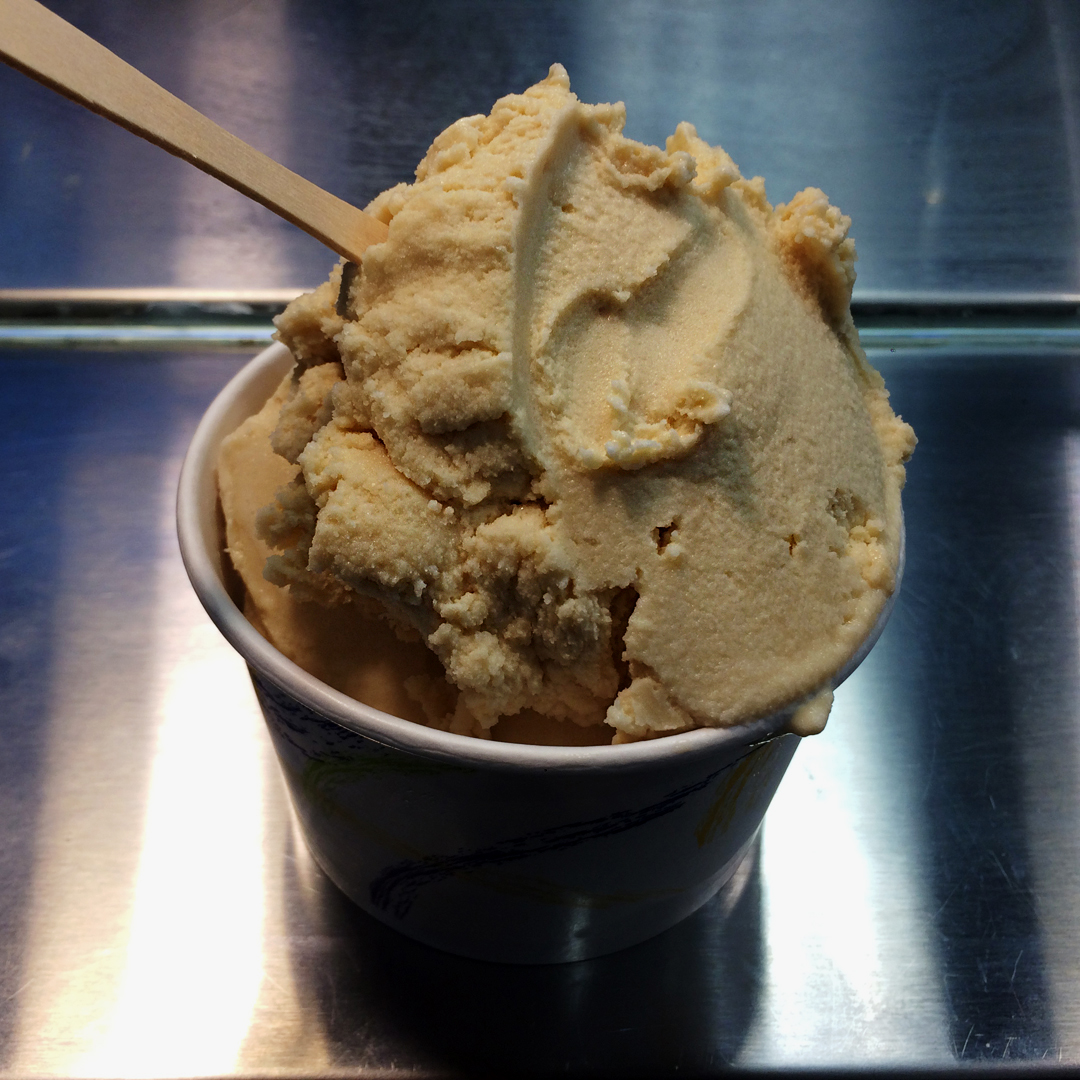 Ever sanguine, we continue to entertain hope for its revival. Moral: Don’t cry over spilt milk, I guess. [Update: See comment below from Food and Footprints regarding a sighting at Kebab Empire’s Manhattan location!]
Ever sanguine, we continue to entertain hope for its revival. Moral: Don’t cry over spilt milk, I guess. [Update: See comment below from Food and Footprints regarding a sighting at Kebab Empire’s Manhattan location!]
Disclaimer: I’m thrilled that New York City is a mecca for bespoke ice cream parlors, each with its own marketing perspective and formidable fungible flavor list. I’ve mentioned a number of them in this piece but obviously I’ve only targeted shops that have a focus on ethnic flavors or styles. So here’s to you too, Sundaes and Cones, OddFellows, Morgenstern’s, Ice & Vice, and so many more who craft wonderfully delicious ice cream and who occasionally dip a finger into some international flavors.
And beyond that, even within my own self-imposed exclusively-ethnic-and-dairy constraints, this post is not intended to be exhaustive in terms of either ice cream varieties or venues. If I’ve left out any of your favorites, please comment below and I promise to do an update. And if by some chance, I haven’t yet tried one of your recommendations, I’ll move it to the top of my to-eat list!


